Categories
- Argentina
- Chile
- Antarctica
- Easter Island
- Falklands (Malvinas)
- Bolivia
- Peru
- Uruguay
- Paraguay
- Brazil
- Venezuela
- Colombia
- Ecuador
- Galapagos
- Panama
- Costa Rica
- Cuba
- Nicaragua
- Honduras
- El Salvador
- Guatemala
- Belize
- Mexico
- Latin American Xmas
Pages
- Street Art of Buenos Aires
- A week in Buenos Aires
- The Jesuit Missions in South America
- Contact Us
- Map of Central America
- First week in Latin America – October 2009
- Home Page
- Map of South America
Archives
- October 2011 (3)
- September 2011 (9)
- August 2011 (10)
- July 2011 (7)
- June 2011 (6)
- May 2011 (11)
- April 2011 (10)
- March 2011 (4)
- February 2011 (5)
- January 2011 (6)
- December 2010 (6)
- November 2010 (4)
- October 2010 (8)
- September 2010 (5)
- August 2010 (7)
- July 2010 (5)
- June 2010 (6)
- May 2010 (6)
- April 2010 (7)
- March 2010 (6)
- February 2010 (9)
- January 2010 (4)
- December 2009 (8)
- November 2009 (5)
- October 2009 (2)
Tehuacán
29th July 2011
Leaving Oaxaca [13] the scenery to the north changed dramatically. Tall cactus plants like dead tree trunks grew straight up above the surrounding bushes.
.
On advice from a local we stopped at Tehuacán [15], a pleasant provincial town, to visit the nearby Biosphere Reserve. A surreal forest of cactus, many endemic and some endangered, thrives here due to the moisture starved air. The adjoining pueblo of Zapotitlán Salinas has 2 fine churches.
.
The province of Puebla has a seasonal specialty in July and August, Chiles en Nogada. It is an amazing dish of chillies stuffed with shredded meat and dried fruit, smothered in a walnut sauce and sprinkled with pomegranate seeds. The flavours explode in the mouth. Too bad we will not be here for the other seasonal specialty, goat stew – in October and November.
.
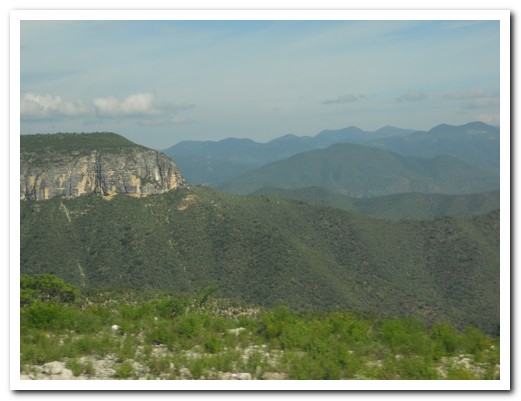
The scenery changes north of Oaxaca ...

... it is much dryer
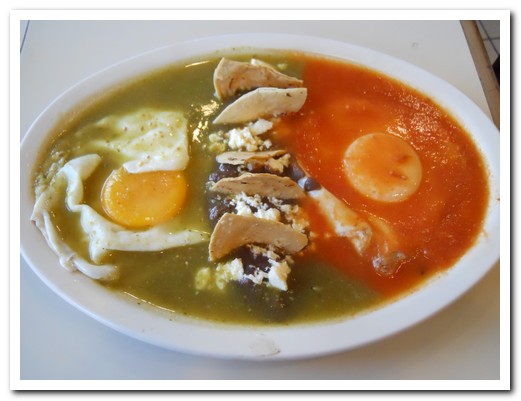
Divorced eggs for breakfast
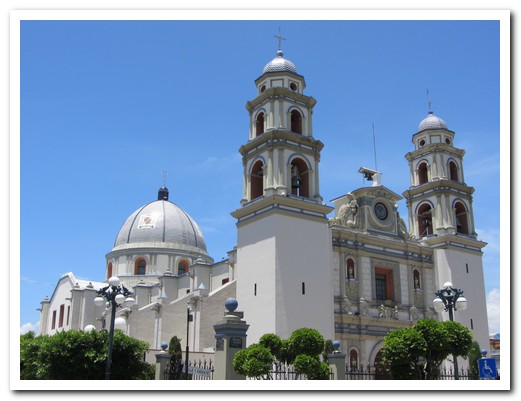
Cathedral at Tehuacán
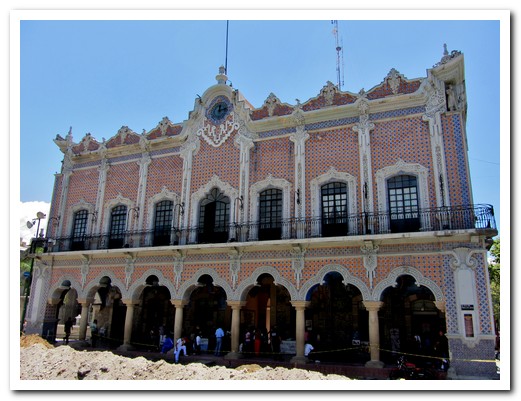
Town hall, built in 1804 in the Moorish style
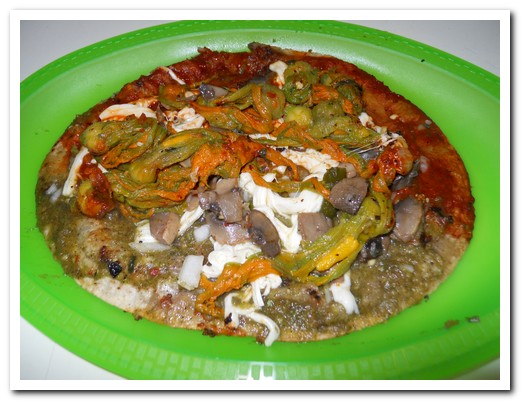
Huarache - not a sandal, but tortillas toped with pumpkin flowers, cheese, mushrooms & beans
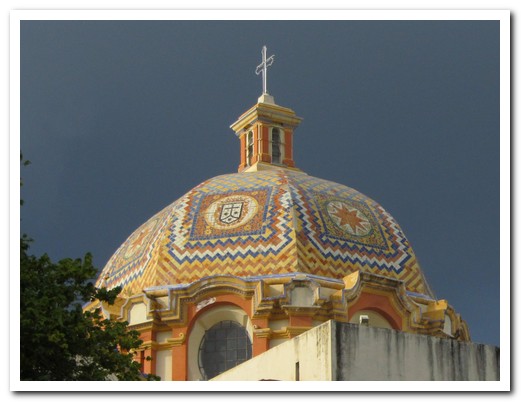
Ex-convento El Carmen
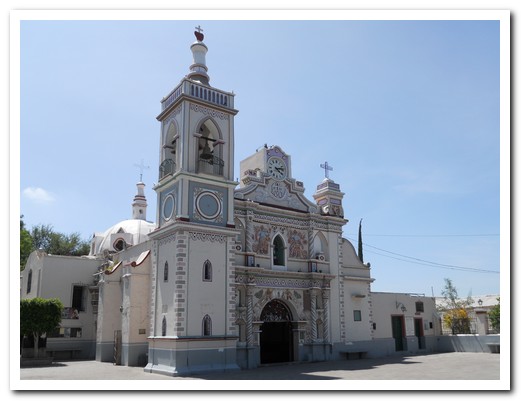
El Calvario
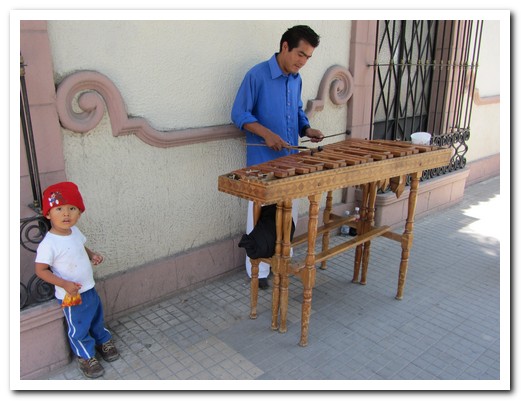
Marimba player on the sidewalk
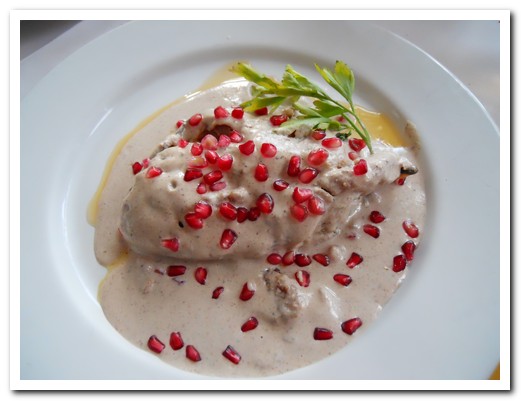
Chiles en Nogada - chille stuffed with shredded meat & dried fruits with a walnut sauce
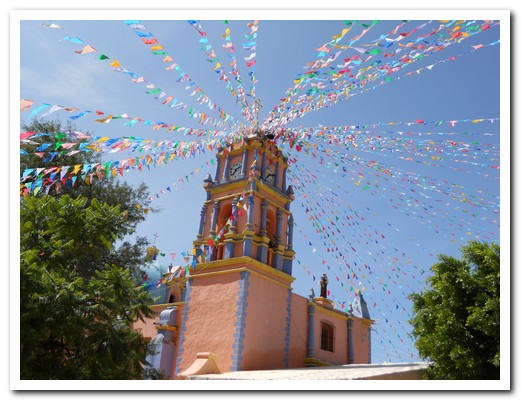
The church at San Antonio Taxcala decorated for a celebration
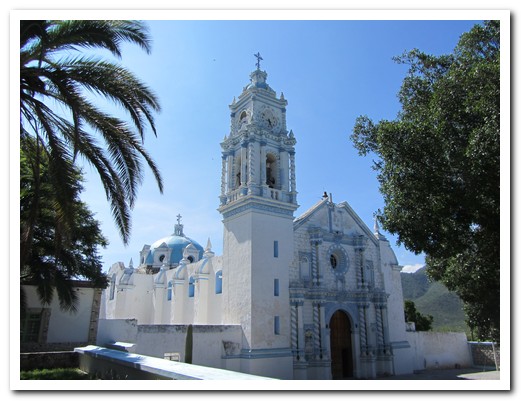
Church at Zapatitlán Salinas
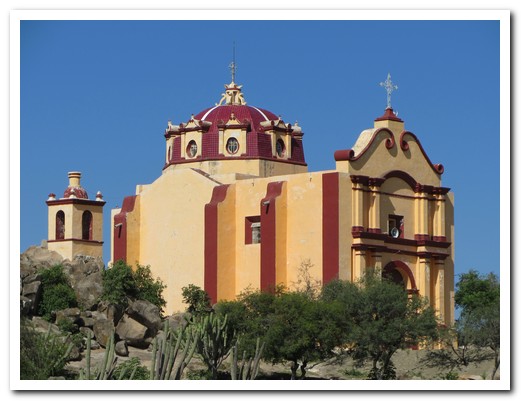
Another church at Zapatitlán
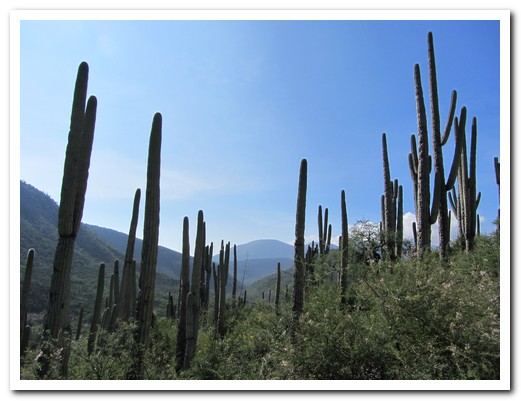
Biosphere Reserve for cactus plants
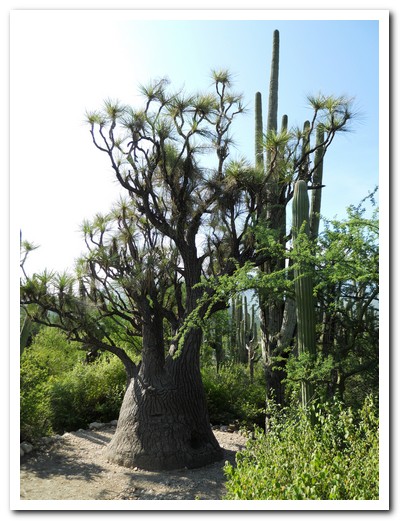
Elephant´s Foot
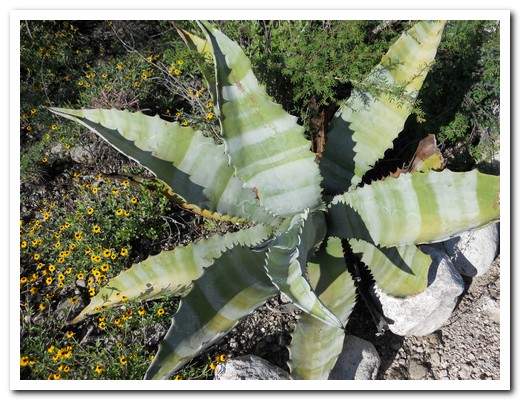
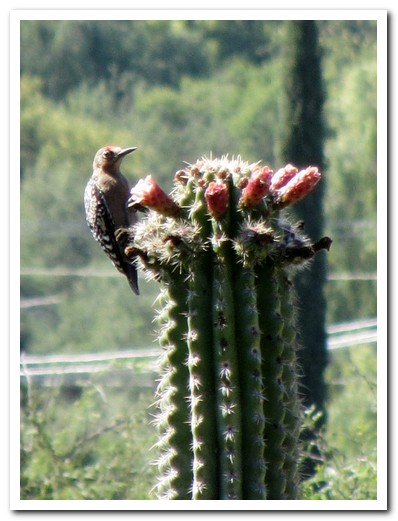
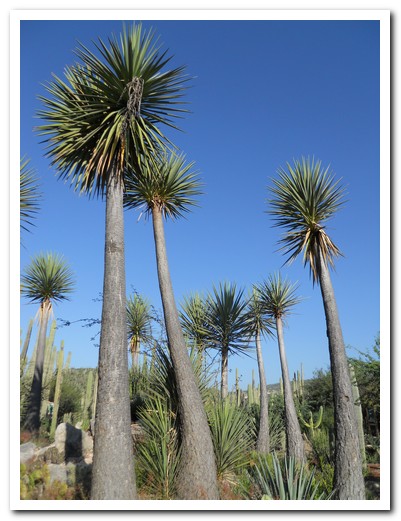
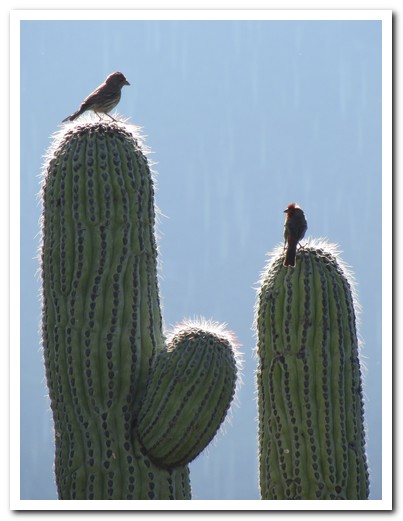
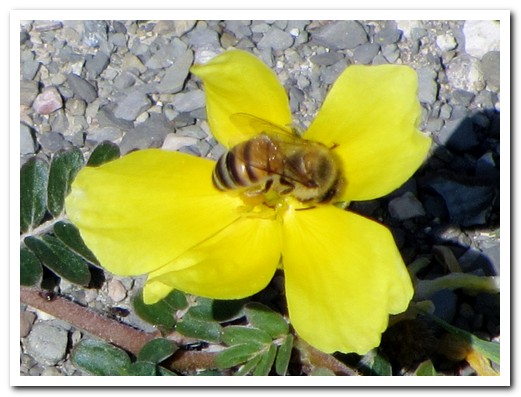
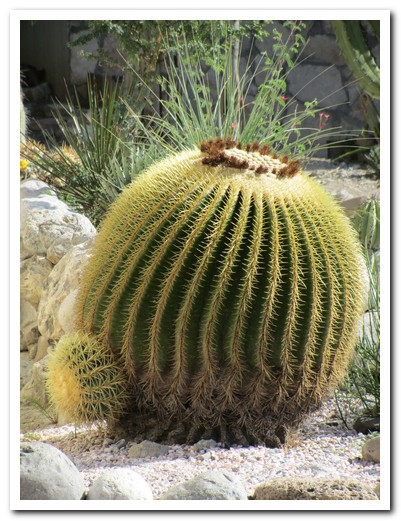
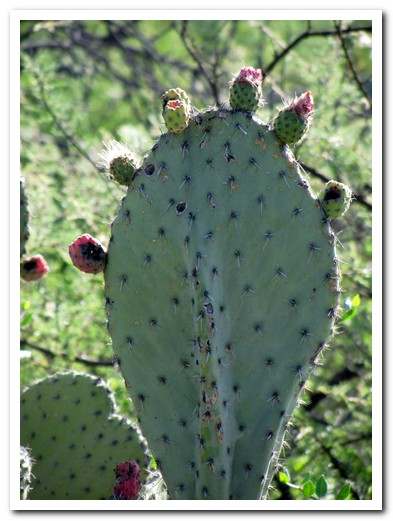
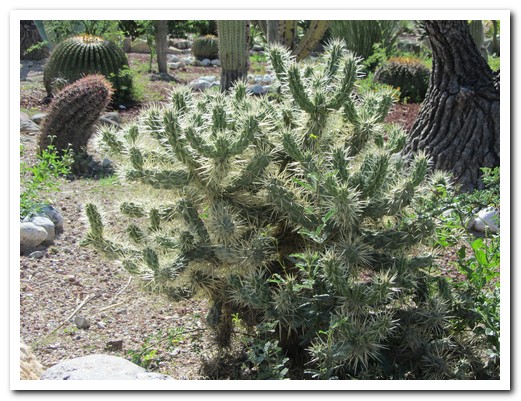
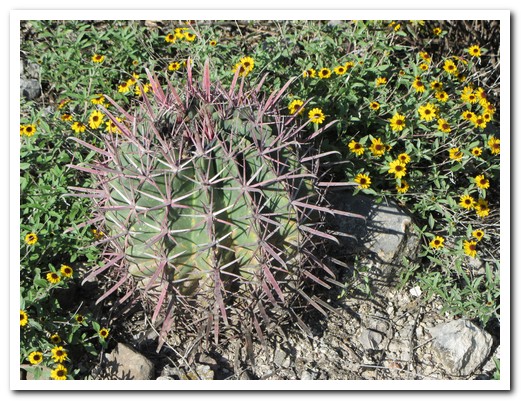
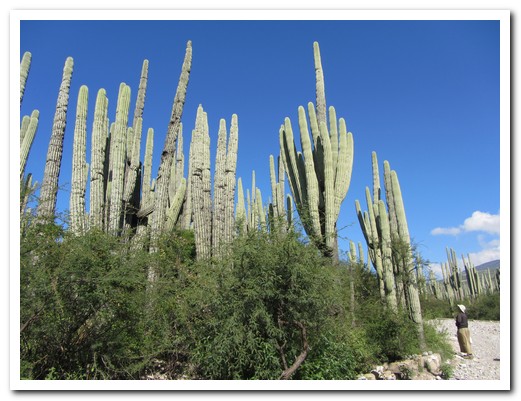
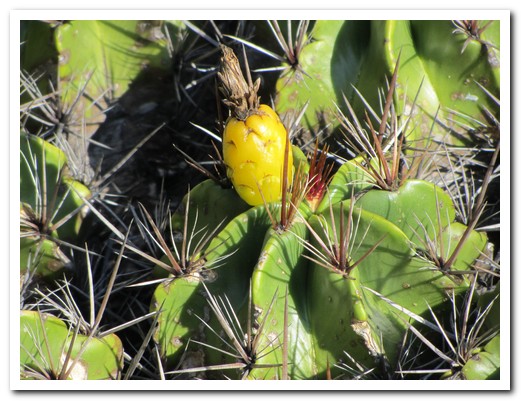
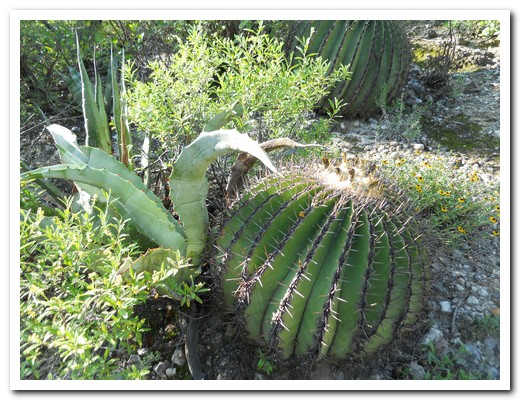
Oaxaca
26th July 2011
After an overnight on the comfortable ADO bus we arrived in Oaxaca [13] to spend a week in a cute little apartment owned by William and Nora on a cobbled street just outside the historic centre. Nora gives cooking classes (Alma de Mi Tierra) in Oaxaca cuisine in her home kitchen. After a visit to a local market to buy ingredients, we made a four course meal including starter, soup, mole, and a sweet tamale for desert. The best part was tasting the finished meal!
.
The city is another colonial treasure with more than 23 churches and ex convents to visit. The main square, or Zócalo, is always full of vendors, locals and tourists, and a good place to people watch. Oaxaca State is famous for its rich and complex moles (sauces) containing up to 30 ingredients painstakingly brought together. We set out to try as many as we could. A black smoky sauce made from chillies, chocolate nuts, seeds, spices and many other ingredients is the most common but they could be green, yellow or red, even one called a tablecloth stainer.
.
We stayed on for the annual Guelaguetza, a traditional folk dance festival by people from the surrounding area. The hilltop stadium holds 10,000 people and there was a near riot in line B as people pushed and shoved to get in first; the police had to step in. With the music, costumes and dance together with the crowd participation, it was a truly emotional experience. After each performance the group threw gifts, including whole pineapples, to the audience. Click here for a short video.
.
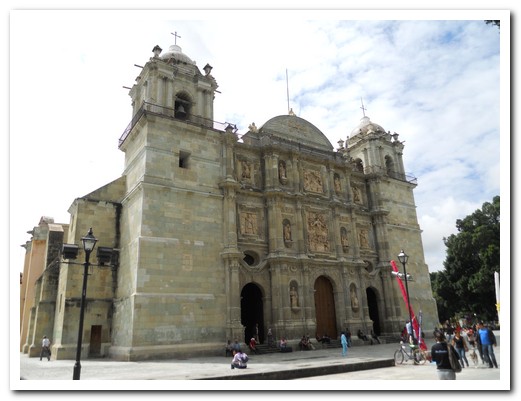
Oaxaca Cathedral began in 1553 but finished in the 18th century
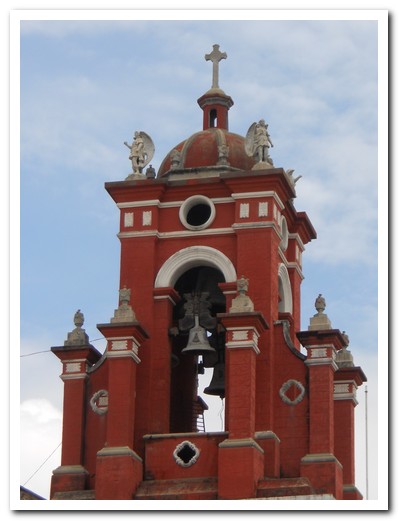
The red bell tower of San Juan de Dios Church

Carved front of Saint Augustine Church
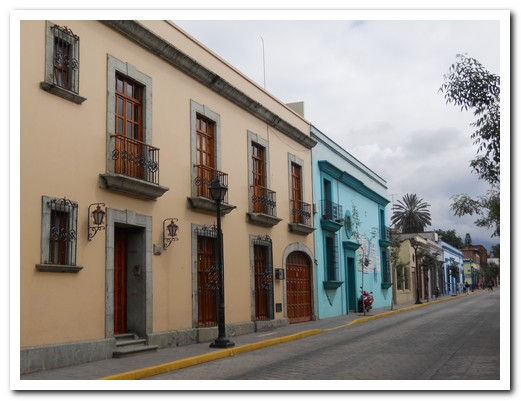
Oaxaca street
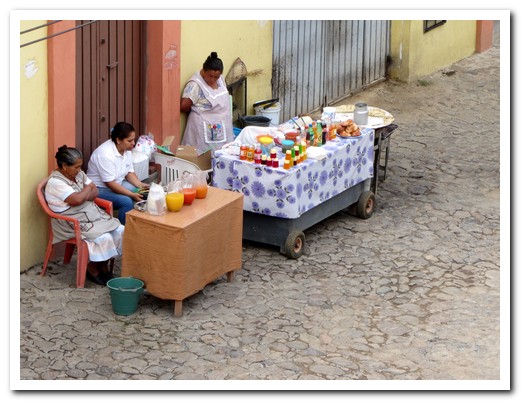
Ladies making breakfast in the street
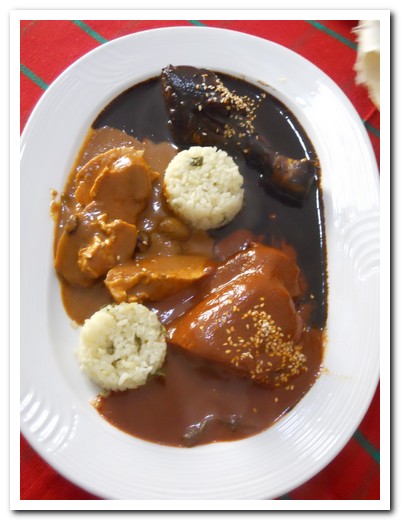
Trilogy of moles - famous rich sauces of Oaxaca
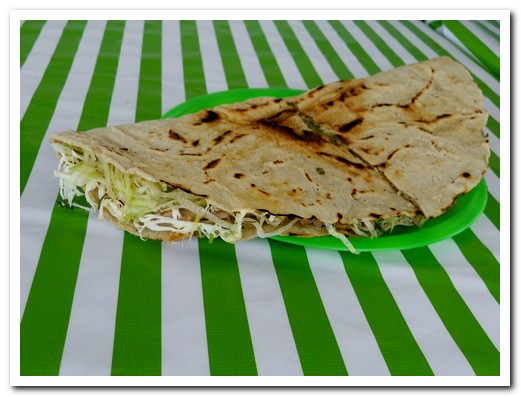
Tlyuda - huge taco that overhangs the plate
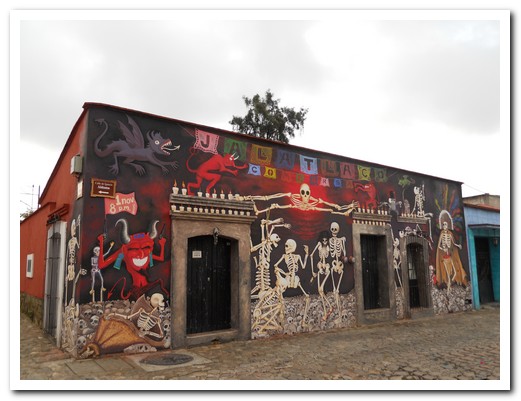
Bar
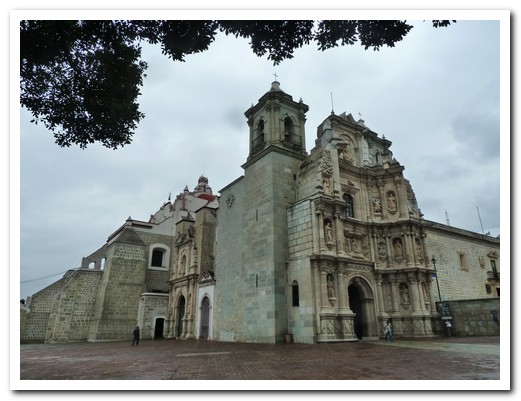
Basilica de Nuestra Señora de la Solidad, Patrona of Oaxaca
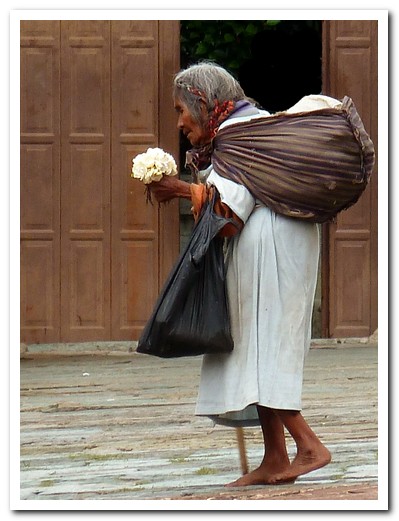
Barefoot lady selling roses outside the Basilica
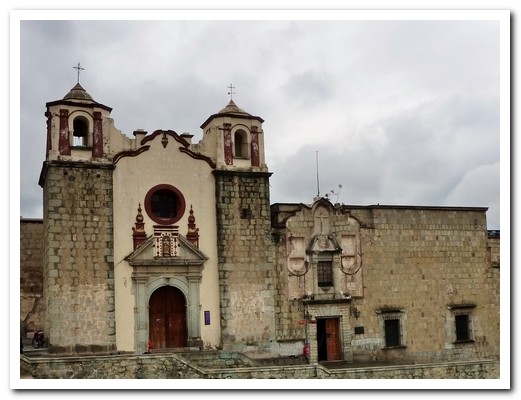
Church and Convent of San Jose, founded 1595 by the Jesuits
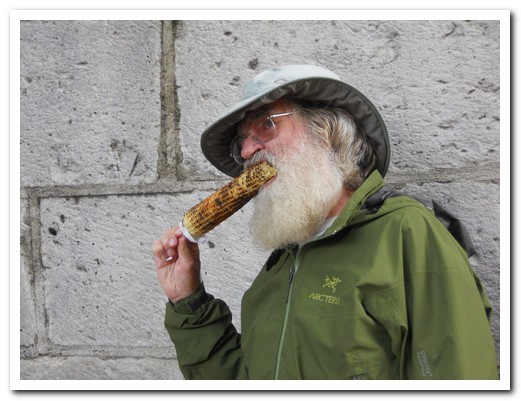
Grilled corn with lime and chilli sold on the streets
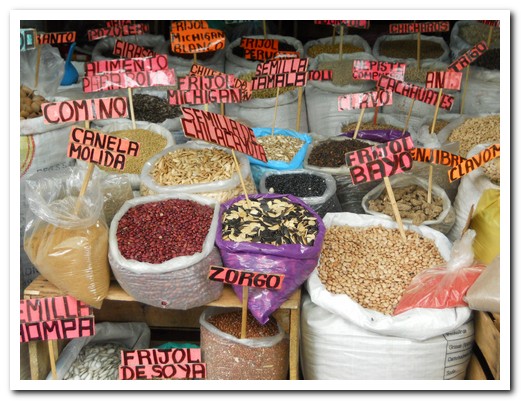
Seeds and spices for sale in a market
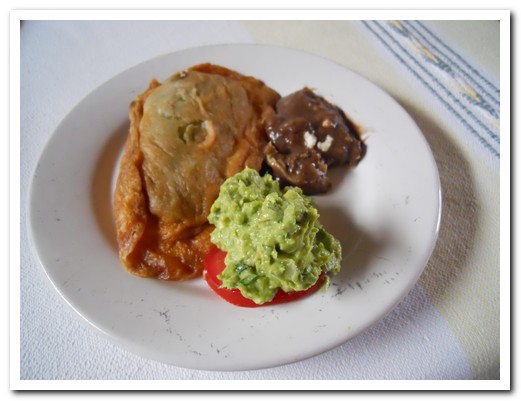
Fried spicy green chillies stuffed with shredded chicken
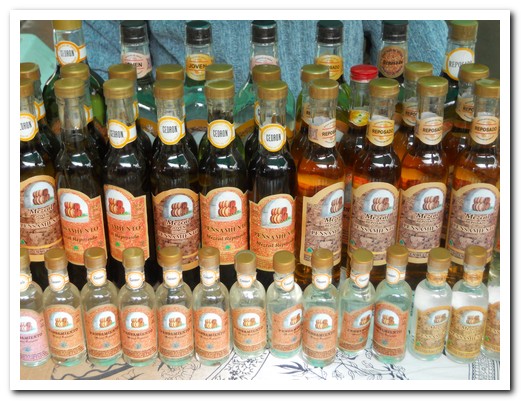
Oaxaca is the centre for Mezcal
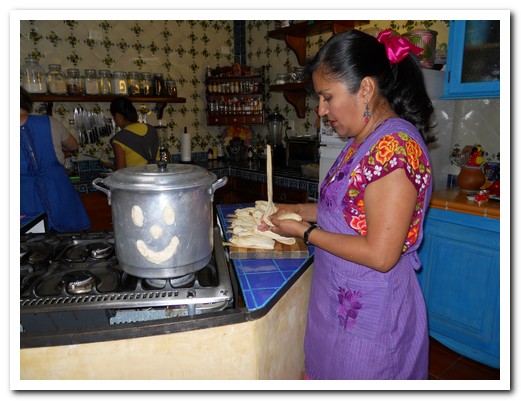
Cooking class with Nora - making tamales
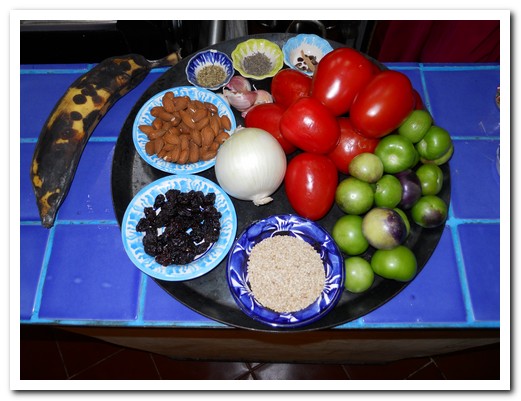
Some of the ingredients for mole estofado
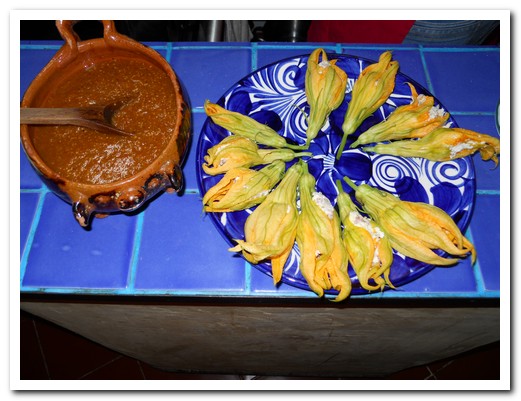
Stuffed squash flowers with a smoky, spicy sauce using maguey worms
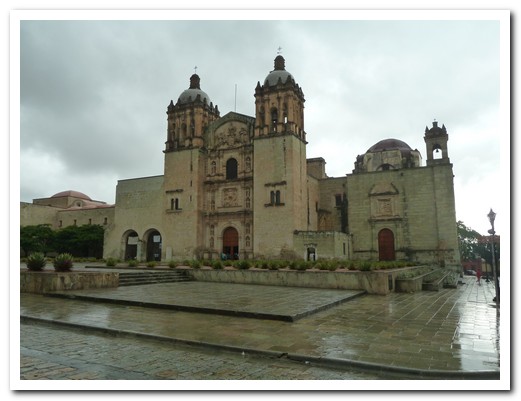
Iglesia de Santo Domingo, built between 1570 and 1608
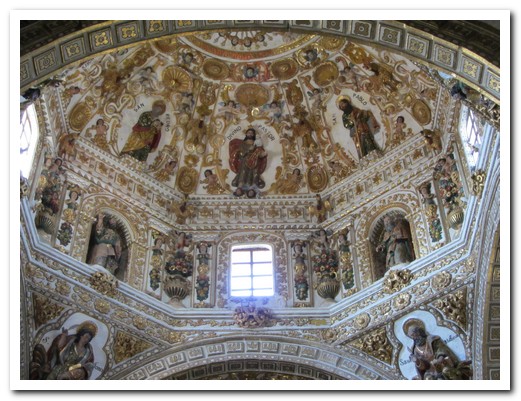
Ornate ceiling inside the Santo Domingo Church
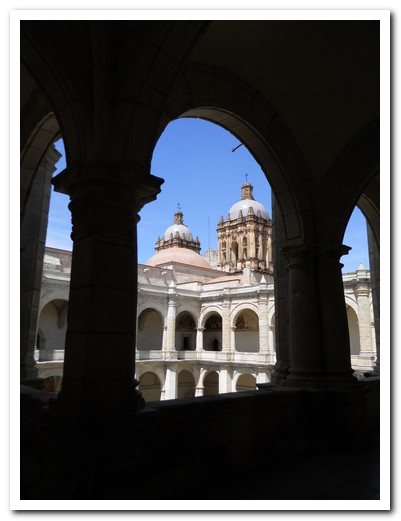
Church from the attached Convento
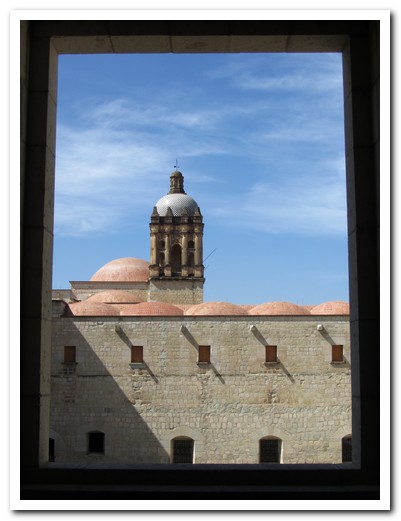
Domed roofs of the Church
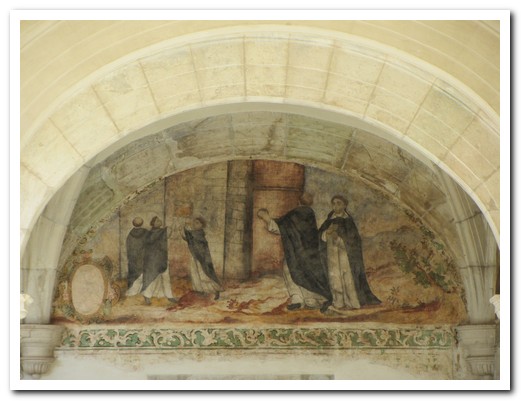
Original mural showing Dominican Friars
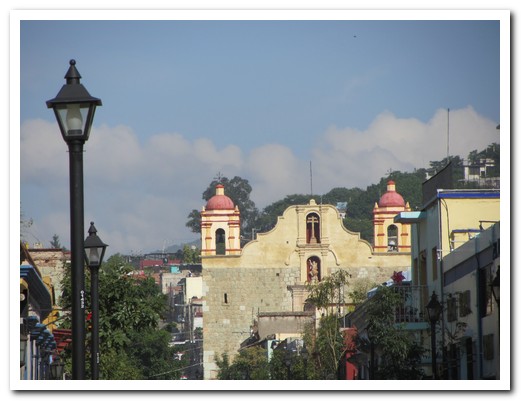
Iglesia la Sangre de Cristo
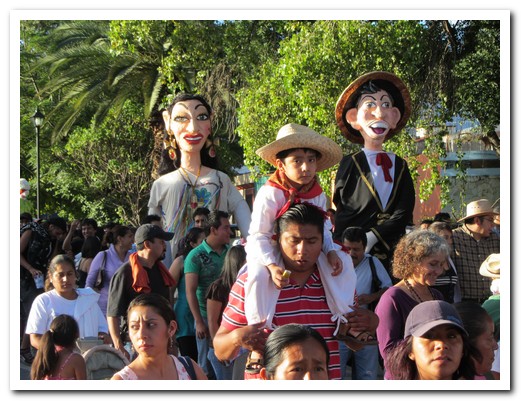
Large figures paraded through the streets signal the start of a fiesta ...
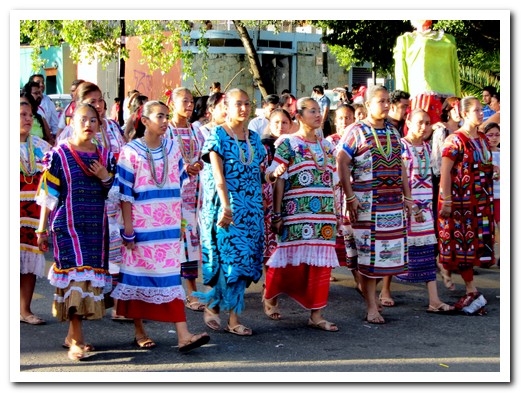
... Guelaguetza has begun!
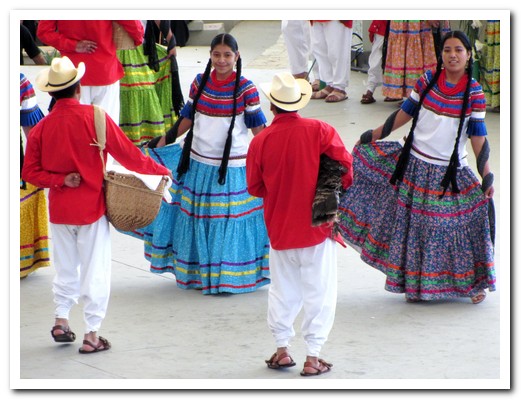
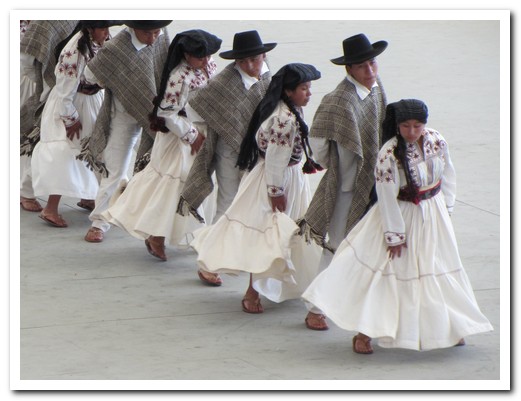
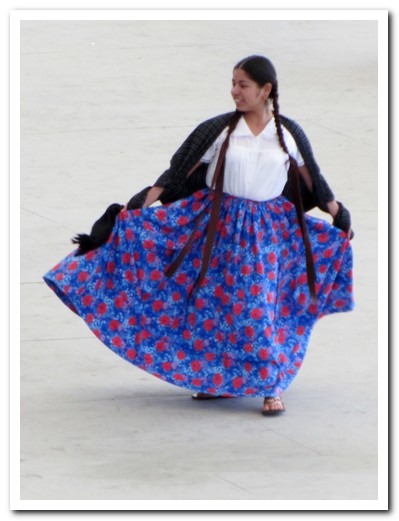
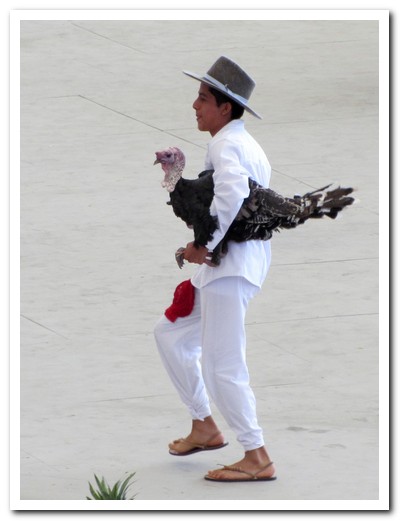
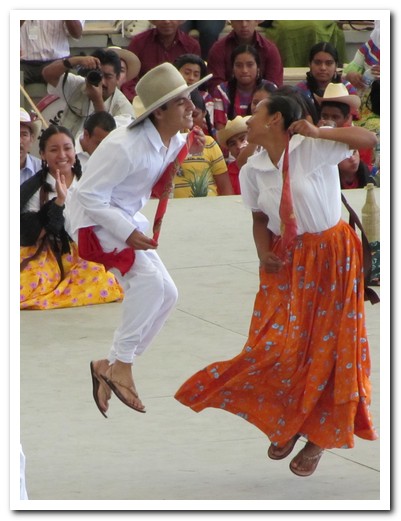
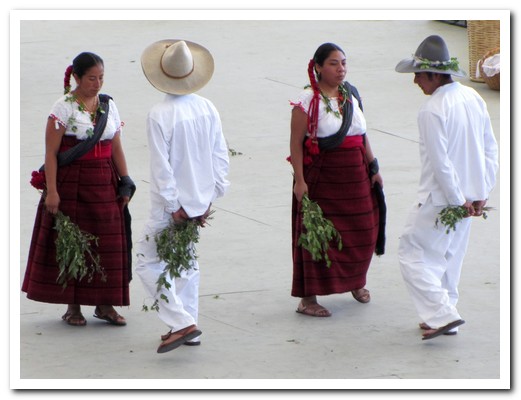
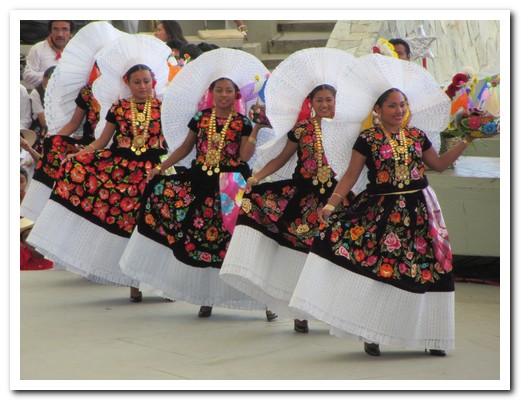
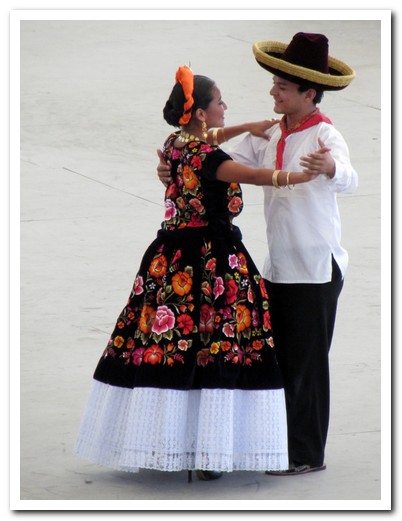
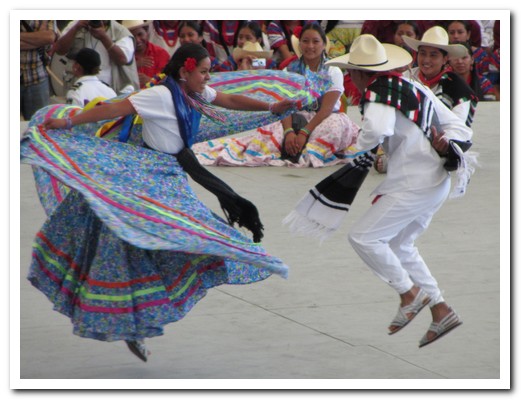
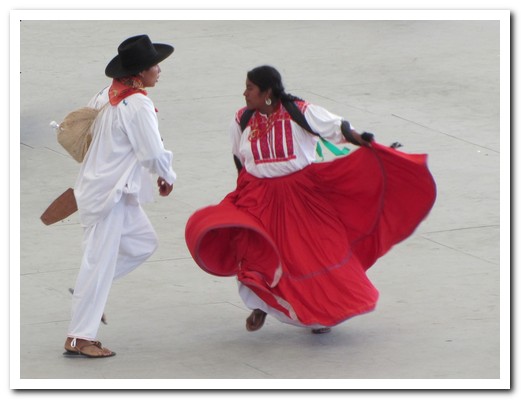
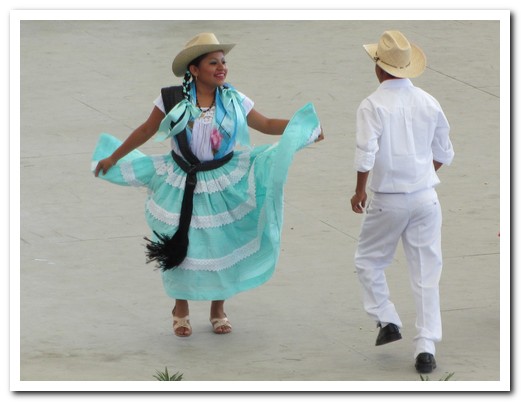
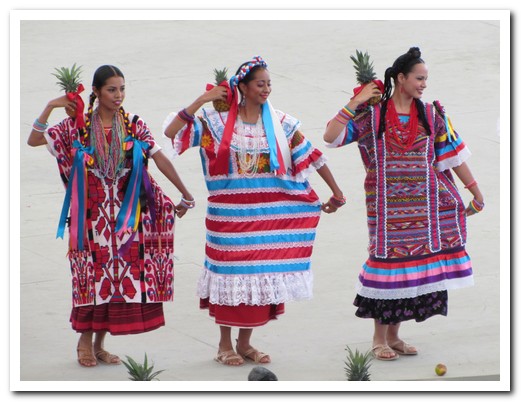
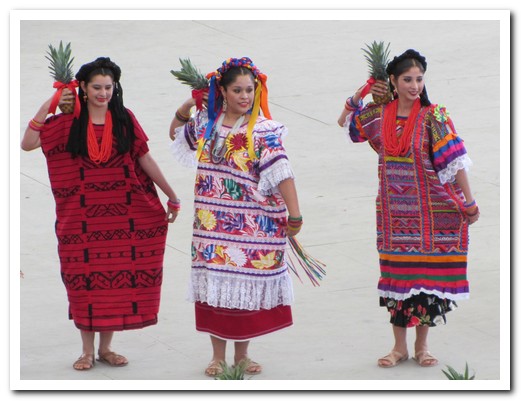
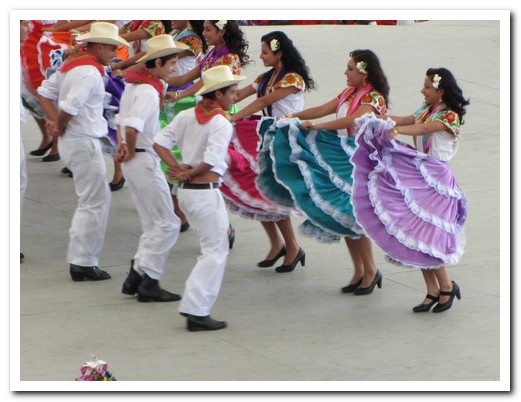
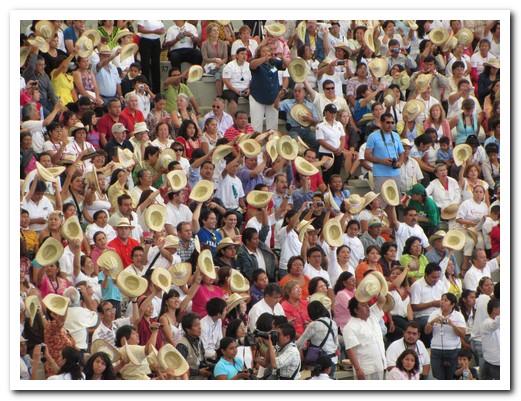
The crowd cheers
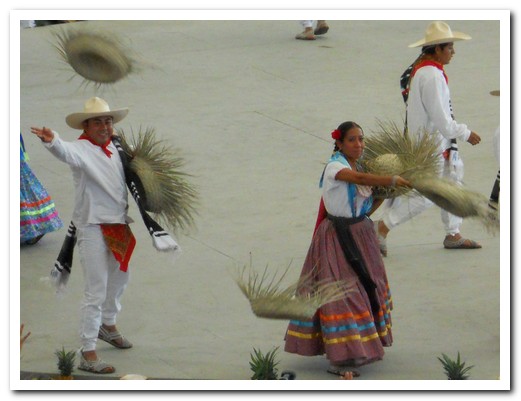
Throwing gifts of straw hats to the crowd after the performance
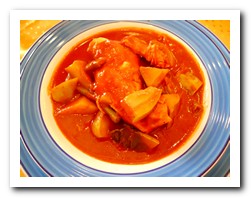 |
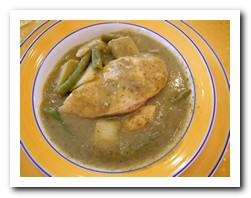 |
| Yellow and green moles for our final meal in Oaxaca |
Guelaguetza 2011, Oaxaca
25th July 2011
Here is a short movie of Guelaguetza in Oaxaca.
.
Hiking around the Pueblos Mancomunados
25th July 2011
8 Zapotec villages, called the Pueblos Mancomunados, lie between 2000 and 3000 meters in the Sierra Norte de Oaxaca (mountains to the north of Oaxaca). The villagers are known as “the cloud people”. They offer experienced local guides along the lovely trails connecting the pueblos. Guests stay in comfortable cabañas with fireplaces and meals are provided by the village women in a successful joint eco tourism venture. It is the best managed and coordinated tourism project we have seen anywhere.
.
Every little detail for us was organised by Expediciones Sierra Norte in Oaxaca beforehand, right down to what colour public bus to take to reach Cuajimoloyas [14] at 3200 metres to begin a 6 hour hike to Latuvi at 2400 metres. 1000 meters down, followed by 200 meters steeply up – our going down muscles and our going up muscles were sore for days!
.
We walked on a path of soft pine needles in a forest of moss and lichen covered trees. Bromeliads clinging to the branches thrive in the humid air. Many types of wild mushrooms had sprung up in the undergrowth. Our guide picked 2 large bright red ones to take to Latuvi to be cooked for dinner. They were delicious with onion and forest herbs.
.
We spent the next 2 day´s walking to the villages of La Nevería at 2800 metres and Benito Juárez at 3000 metres. Each community was welcoming and friendly. The scenery changed daily. Near the pueblos corn grew up steep slopes and wildflowers in every colour grew on grassy hills. The weather though cold, stayed fine and we enjoyed a fire in our own little cabaña.
.
We walked back to Cuajimoloyas on day 4 along the most beautiful forest paths. On August 6 and 7 there is a wild mushroom fair which includes gathering and cooking mushrooms from the surrounding woods. We are sorry we are going to miss it.
.

A beautiful day to start hiking from Cuajimoloyas (3200 meters)
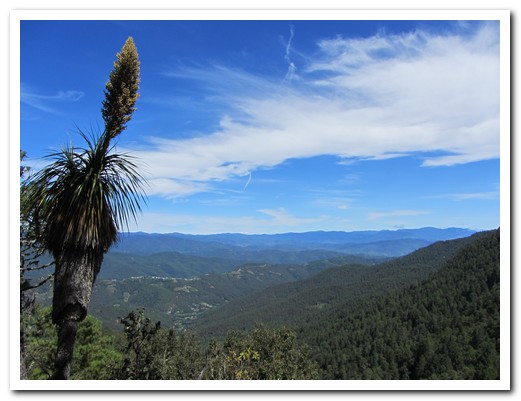
The lookout halfway to Latuvi
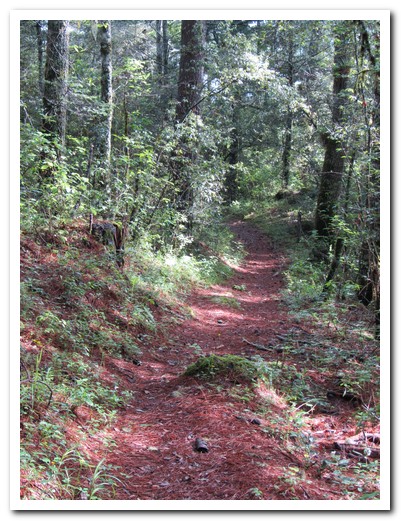
The path through the forest is ...

... waymarked (in places)

Goats on the road, tended by a man and a boy on bike
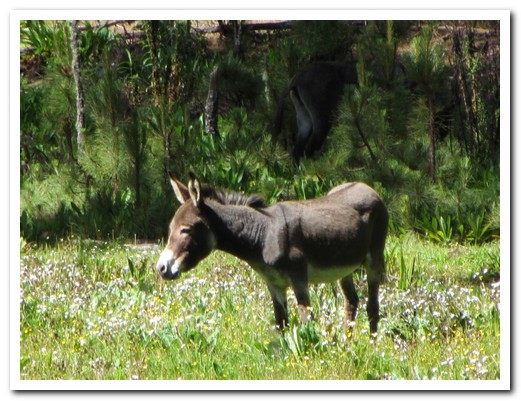
Donkey feeding on wildflowers
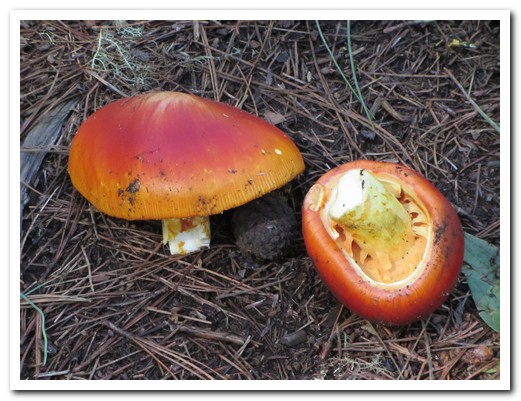
Hongos Rojos (wild red mushrooms) - cooked with onions and herbs, delicious
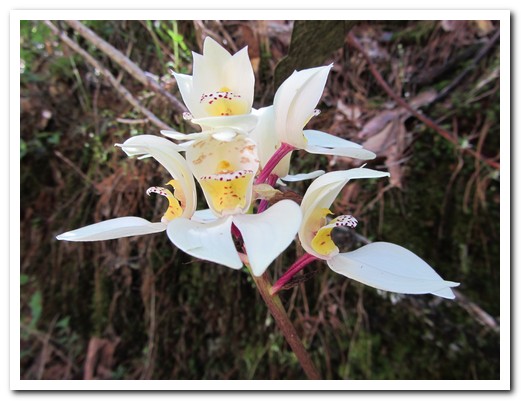
Azucenas (white lilies)
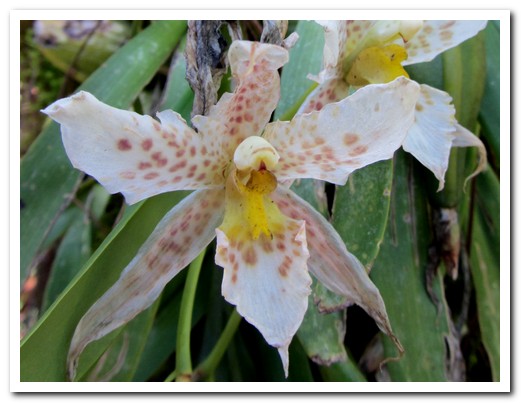
Orchid
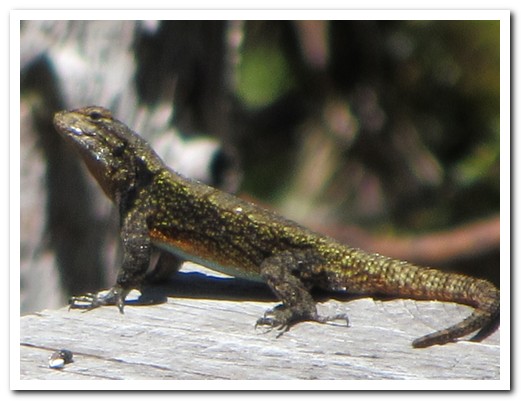
This lizard did 3 pushups every time he stopped
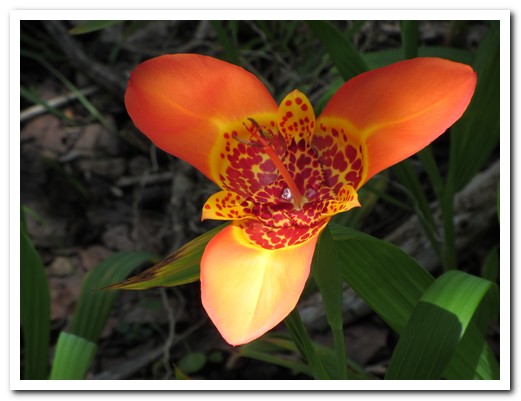
Mariposa flower only lasts a day
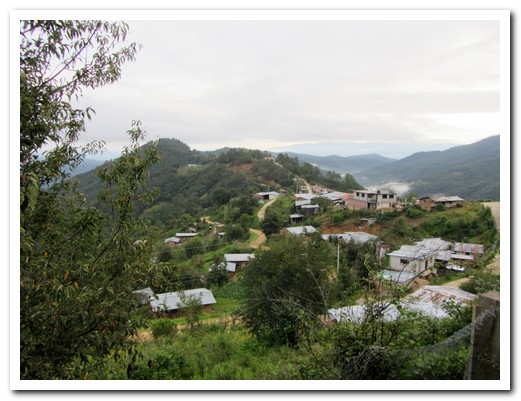
Village of Latuvi (2400 meters)
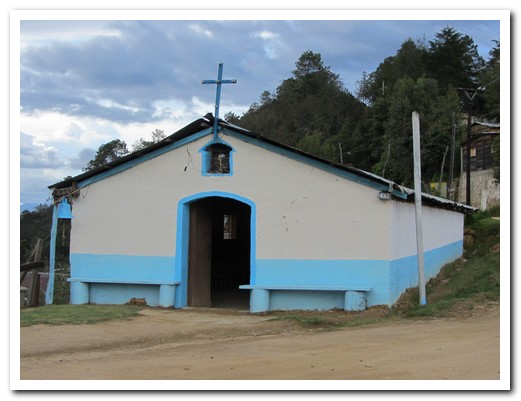
The small church at Latuvi
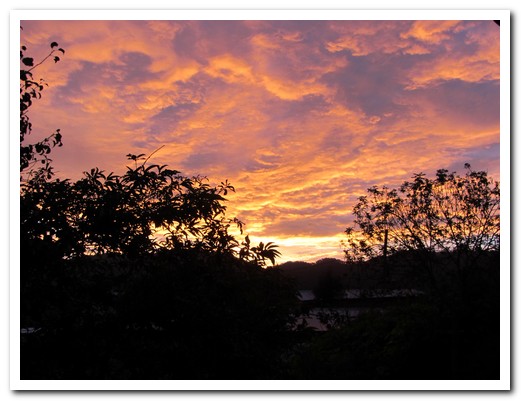
Beautiful mountain sunrise
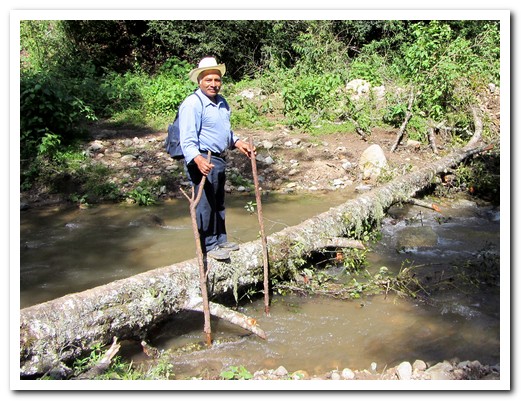
Our guide Carlos crossing a creek
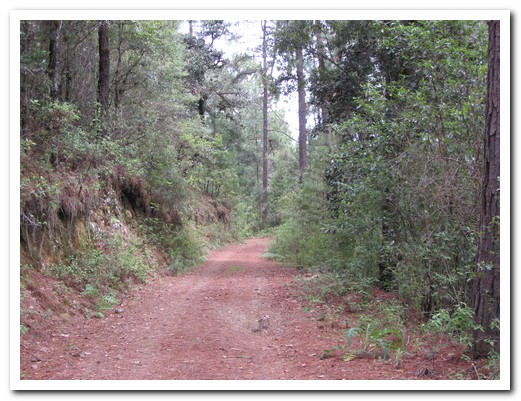
Some of the way was on forest roads
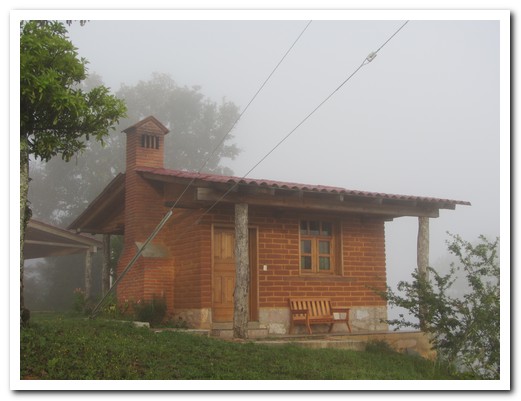
Our cabaña in La Nevería
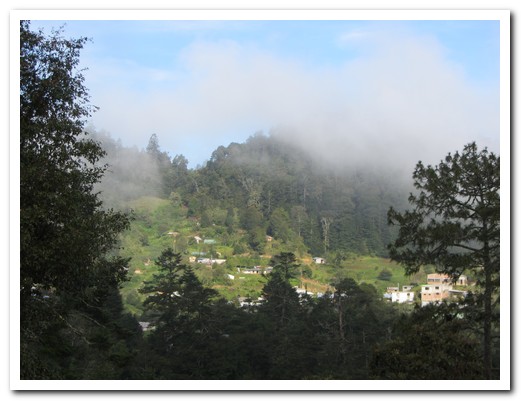
The tiny, 17 family, village of La Nevería (2800 meters)
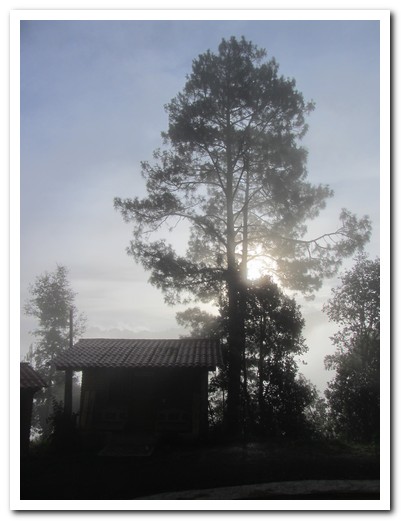
Sun trying to break through the fog

Guide Alfredo leads us up through the forest
 |
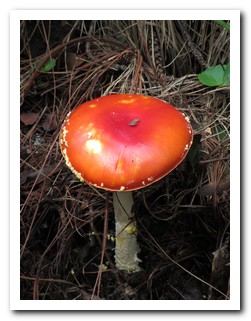 |
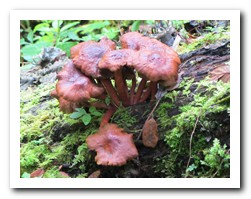 |
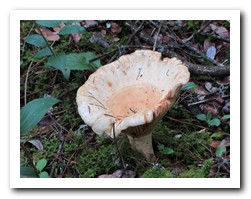 |
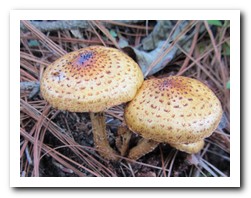 |
 |
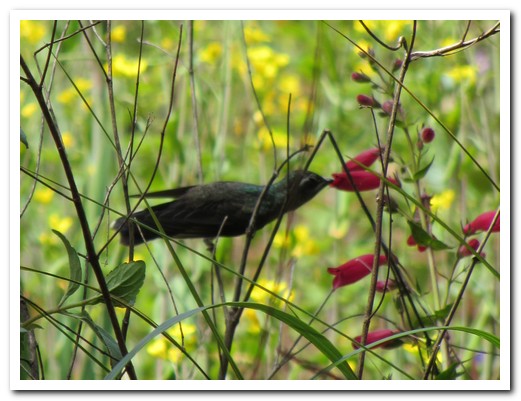
Hummingbird
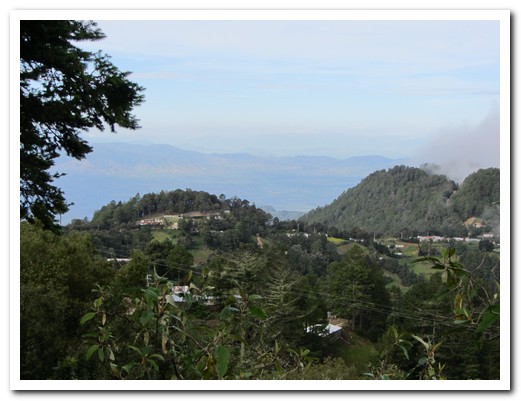
Leaving Benito Juárez (3000 meters)

Wild flowers
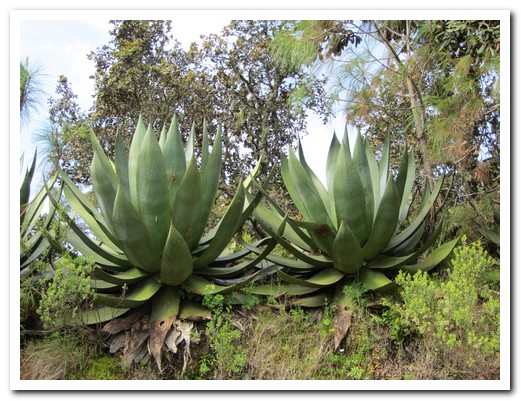
Huge agave plants
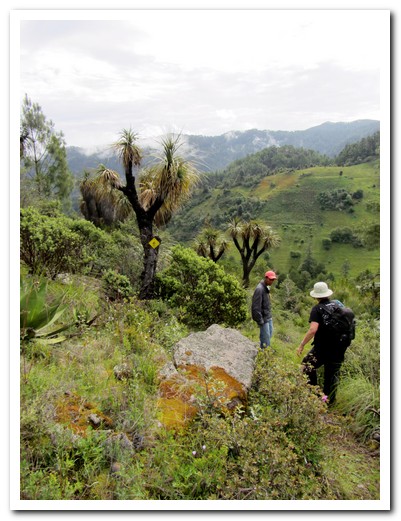
Strange trees on the hill side
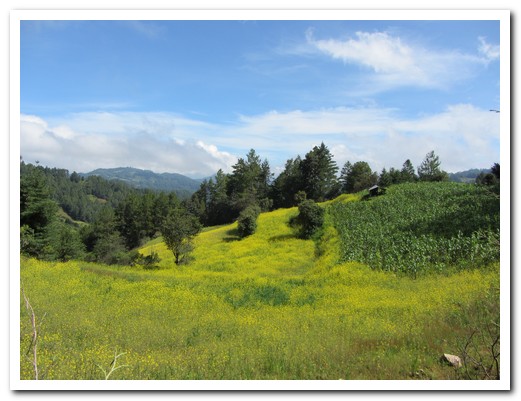
Field of corn and mustard

Lizard sunbaking
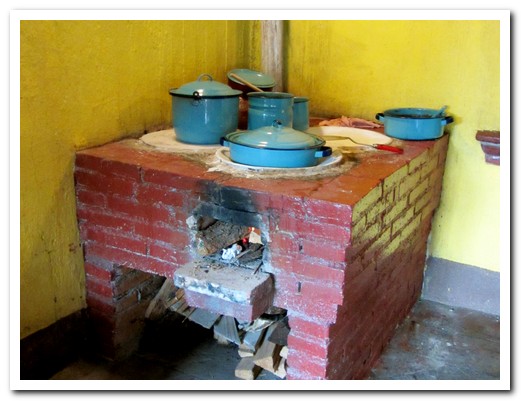
Food tastes better cooked with leña (firewood)
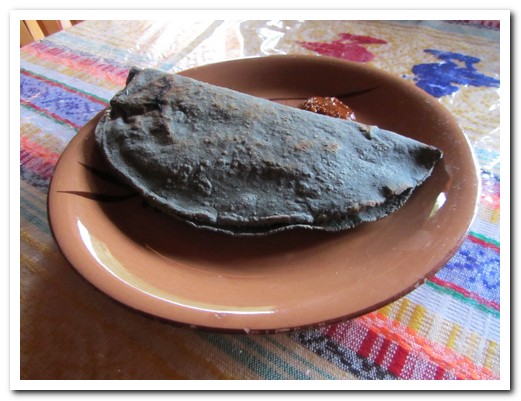
Quesadilla made with black corn stuffed with ...

... giant wild mushrooms
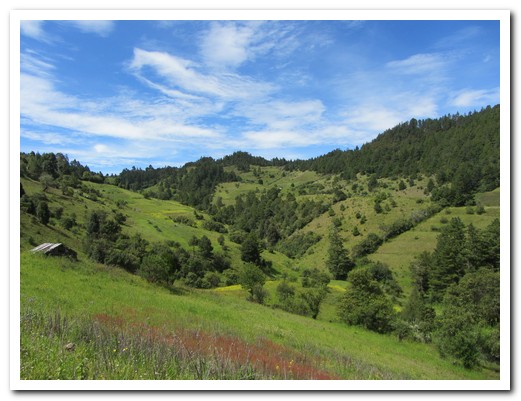
Mountain scenery

The path goes through wildflowers

Field full of tufty grass
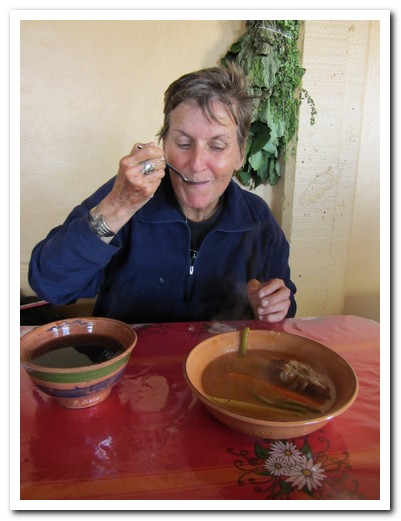
Pam´s really enjoying a final village lunch

Poster for the upcoming wild mushroom fair in Cuajimoloyas
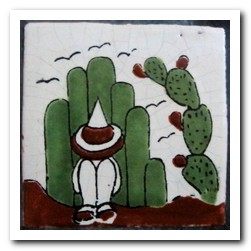 |
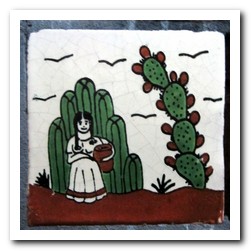 |
| His and hers baños |
Around Oaxaca
20th July 2011
Three valleys radiating out from Oaxaca [13] are populated by small villages. The best time to visit is on market days when they come alive with bustle and colour.
.
To the south, San Bartolo Coyotepec is known for its shiny black burnished pottery, barro negro, the techniques developed by the late Doña Rosa many years ago. In Cuilapam, the stone ex Dominican monastery of Santiago Apostal dominates the skyline. The Dominicans were converting the indigenous in the area and did so quite quickly, but to reinforce the new faith they built a huge convent with murals depicting Christian beliefs with an indigenous influence. It became so expensive that it was never completed with construction halted in 1570.
.
In the valley east of Oaxaca, the village of Tlacloula holds a large market on Sundays with vendors selling anything from tiny edible insects to yokes for oxen and anything in between. Further away in Mitla, the colonial church was built on the ruins of an ancient Zapotec ceremonial centre. Mitla is unique in the elaborate and intricate mosaic geometric designs that cover its walls. These mosaics are made with small, stone pieces which have been fitted together without the use of mortar. We arrived in town just as their Guelaguetza festivities of dance and music was about to begin. Invited in, we thoroughly enjoyed the show and the pueblo atmosphere helped along as Mezcal was handed out freely and the performers threw gifts to the crowd. There were 2 tourists (us). Teotitlán del Valle is a famous weaving village where brightly coloured blankets and rugs hang in the streets. Traditionally natural dyes such as cochineal and indigo are used.
.
On a hill (Monte Albán or White Mountain) to the south west of Oaxaca City are the ruins of an ancient Zapotec capital. Sitting on a ridge 400 meters above the valley floor, it was the most important Zapotec centre for over 1,000 years from 200 BC. The buildings were once covered in stucco and painted red.
.
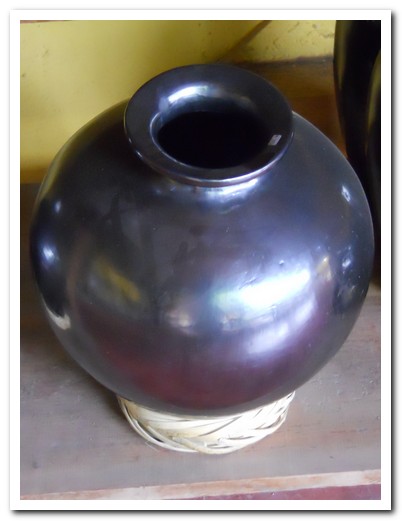
Black pottery from San Bartolo Coyotepec – the process developed by ...
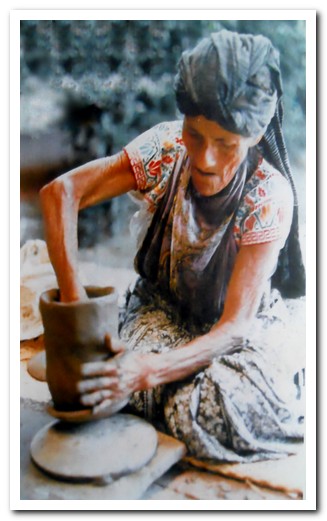
... Doña Rosa many years ago, made on 2 saucers
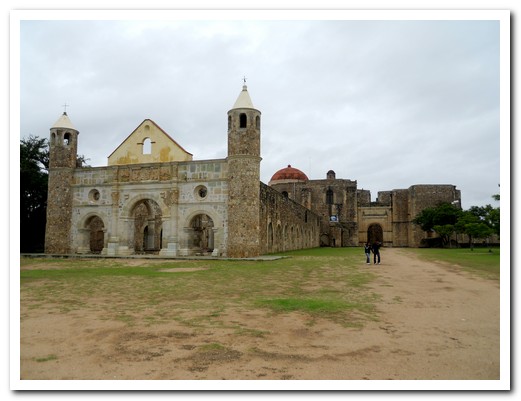
The Dominican Monastery (16th century ) in Cuilapam, was never completed
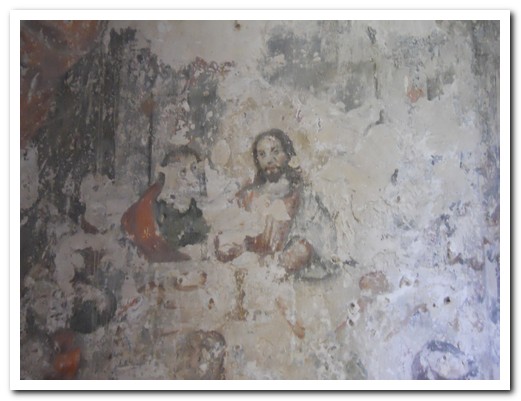
Mural inside the Monastery
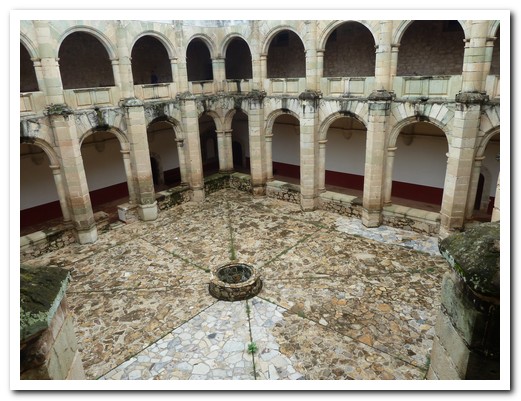
Monastery courtyard

Indigenous depicted in a mural
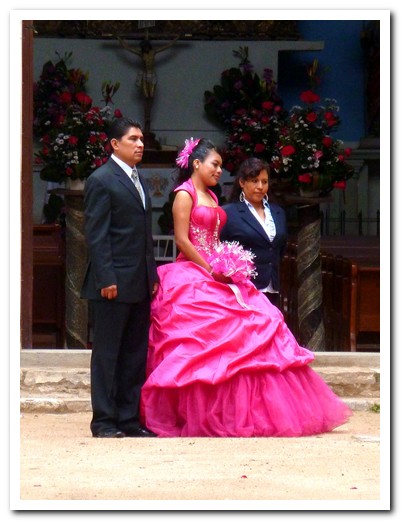
Quinceñera (15th birthday) is an important celebration
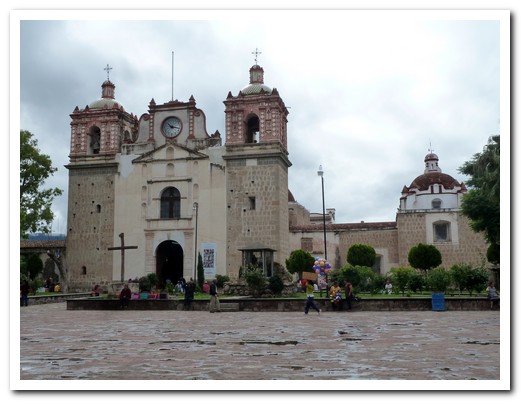
Tlacolula (to the east of Oaxaca) church
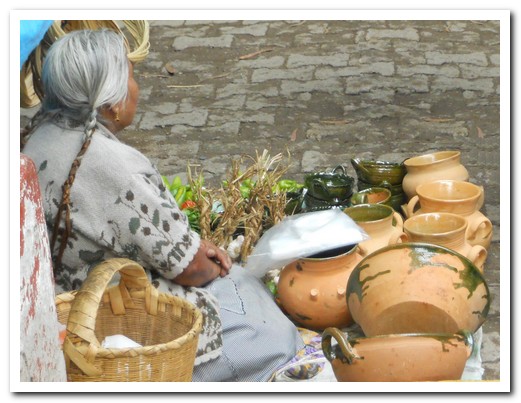
At Tlacolula Sunday market an old lady sells green pottery
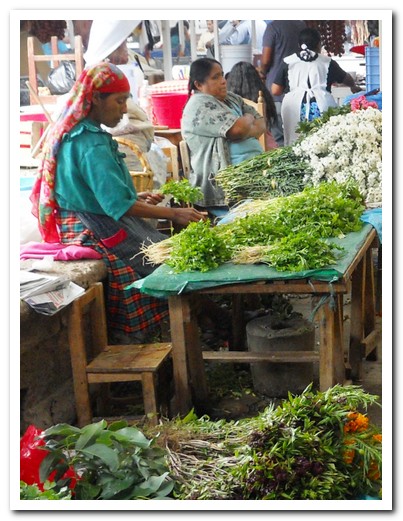
Some ladies wear pretty headscarves
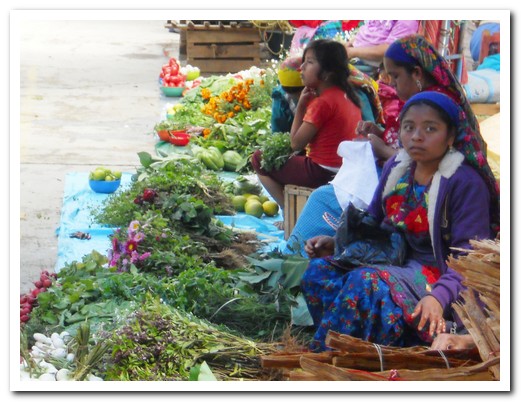
Girls sitting on the floor to sell their produce
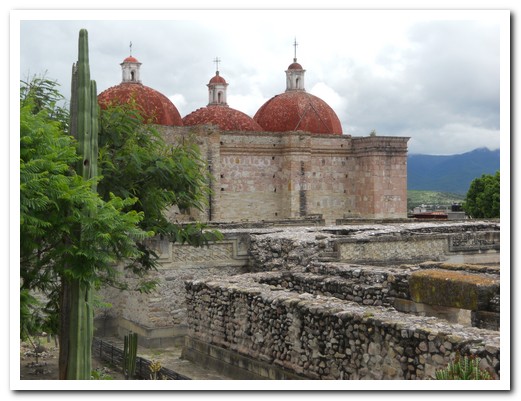
3 domed church at Mitla built over Zapotec ruins
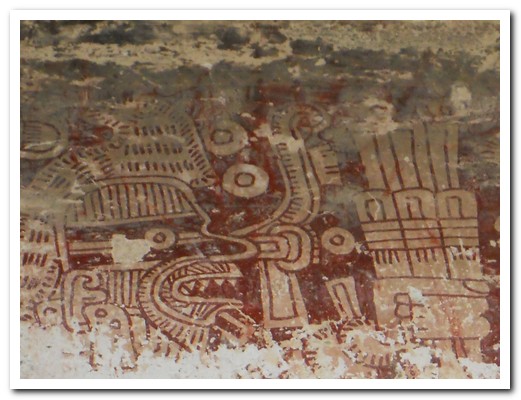
Traces of a fresco from the Zapotec times
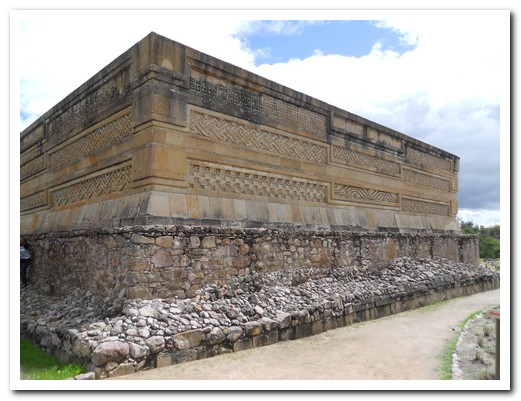
Part of the Zapotec city
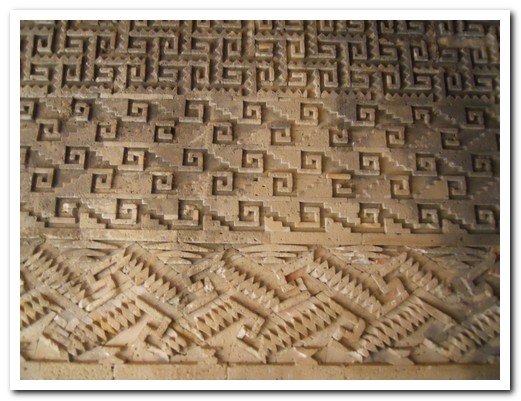
Mosaic patterns are all over the walls
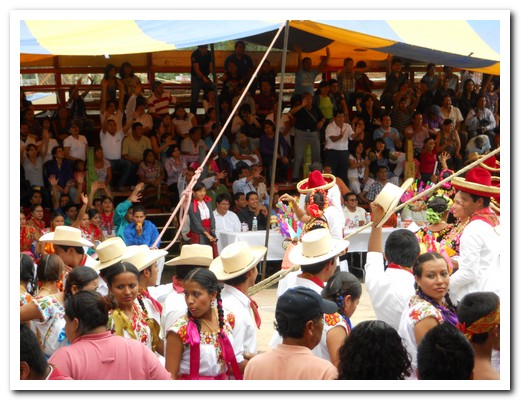
A happy crowd of people at the Guelaguetza in Mitla (festival of dance and music)
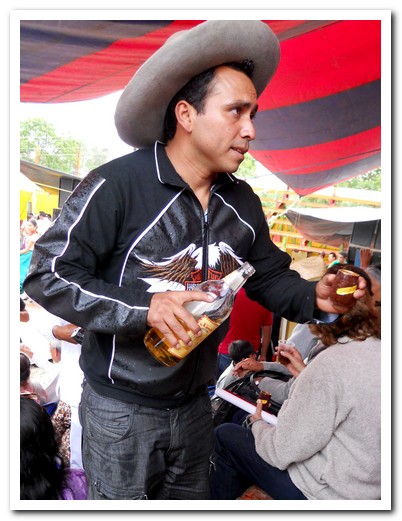
Helped along by a man handing out free Mezcal
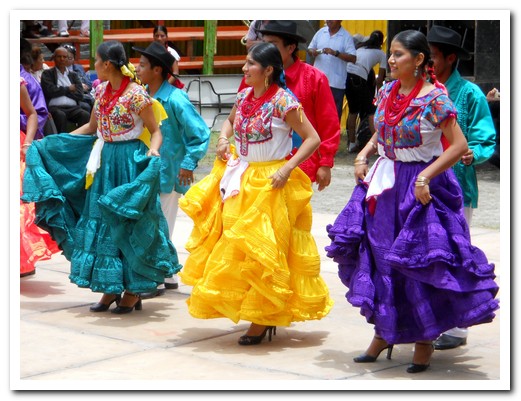
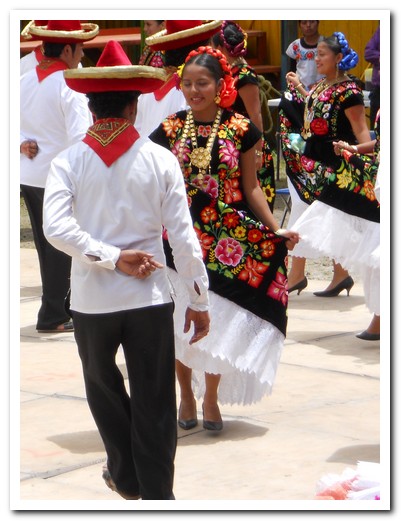
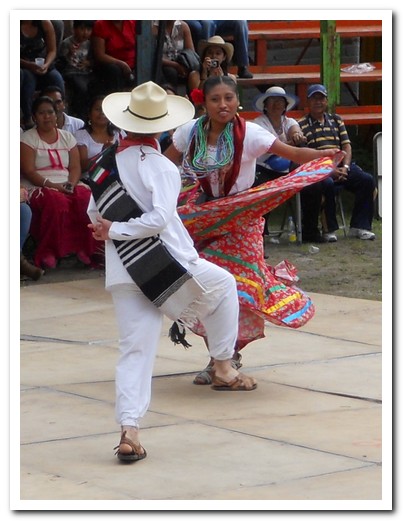
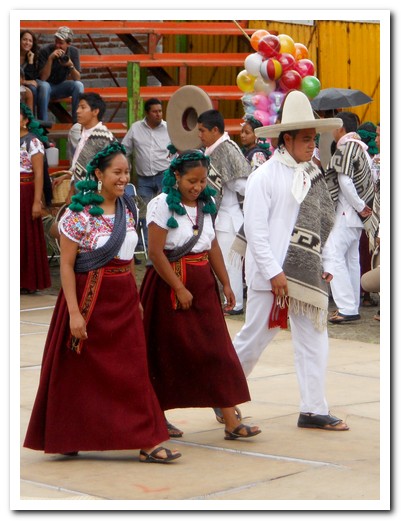
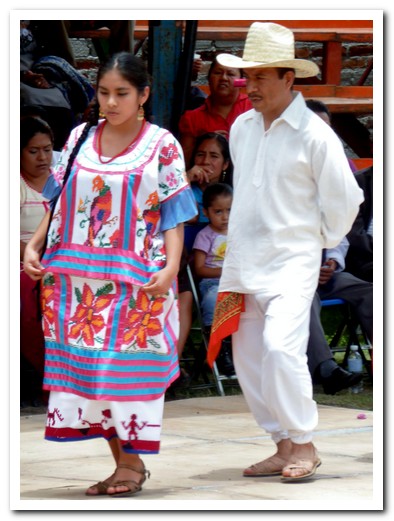
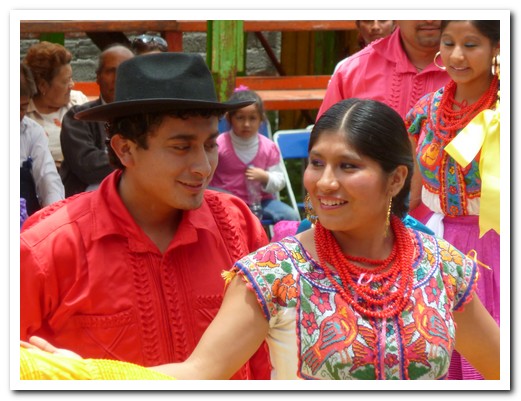
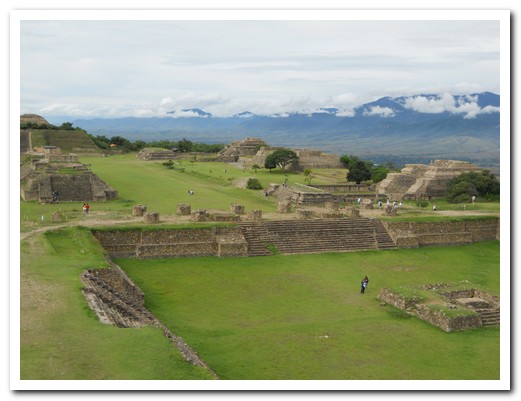
Ancient Zapotec site, Monte Albán
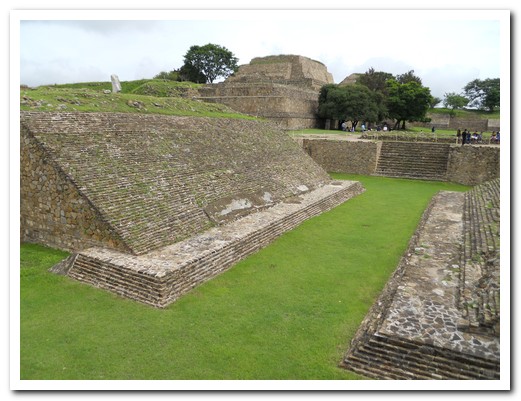
Ball court
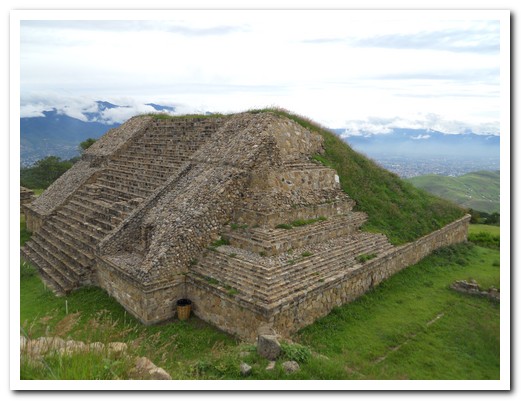
Pyramid
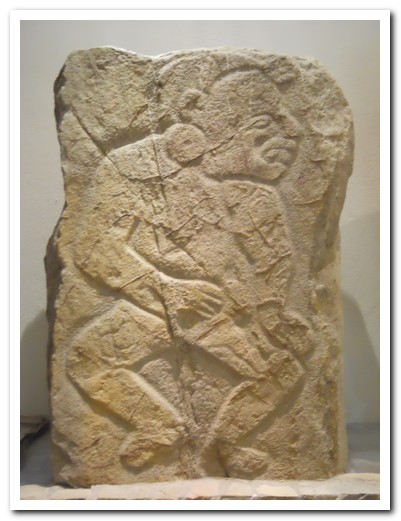
Carved stone panel shows a dancer
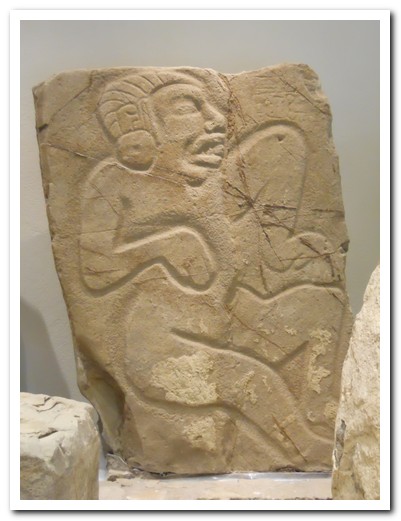
Another dancer
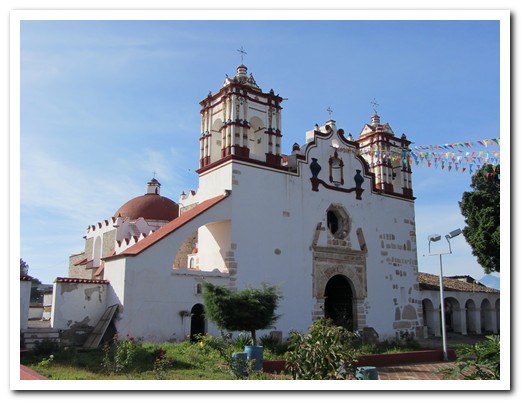
Village church at Teotitlán del Valle
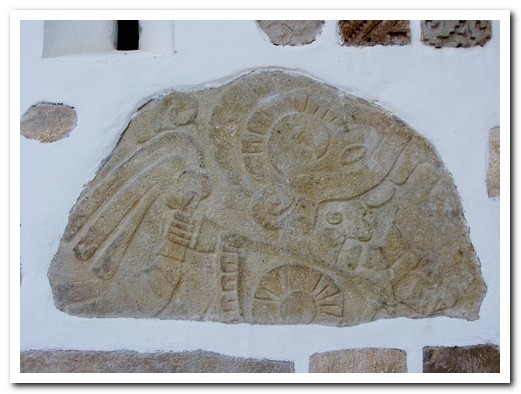
Pre-Hispanic temple stone used in the church
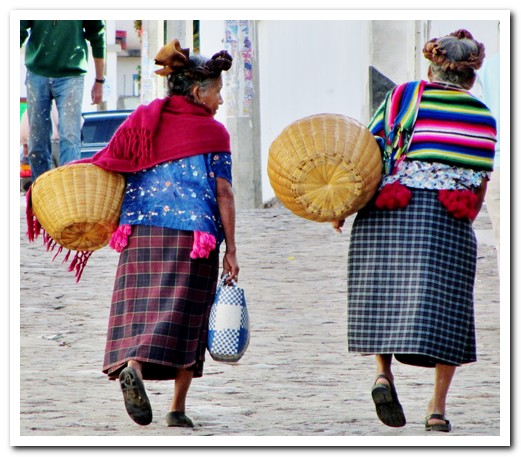
Two old ladies walking to market
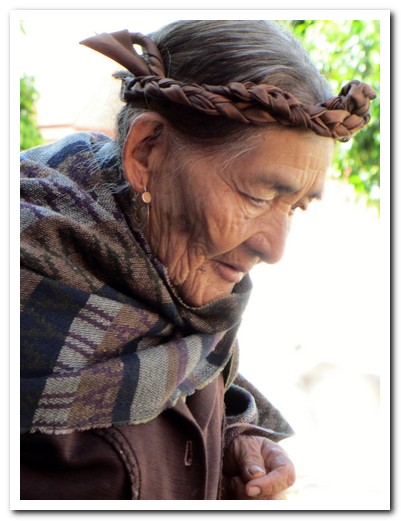
Ribbon braids wrapped around her head
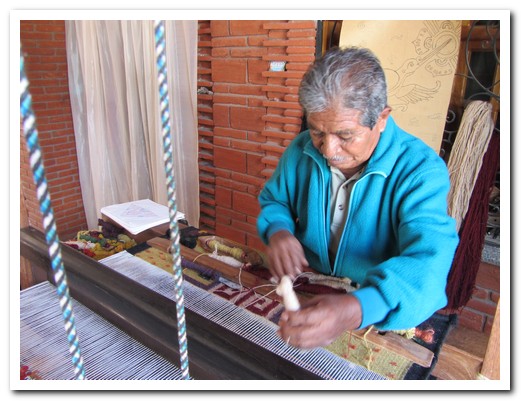
Isaac Vasquez demonstrating rug weaving
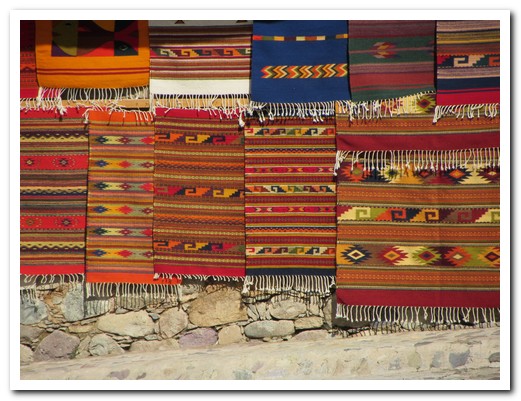
Lovely patterned wool rugs for sale in Teotitlán
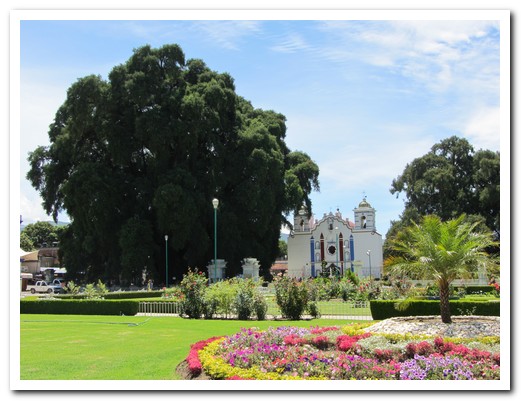
World´s biggest tree (2000 years old) dwarfs the church at El Tule
San Cristóbal de Las Casas
13th July 2011
It´s 165 kilometres from Palenque [11] to San Cristóbal de las Casas [12], but the bus takes over 5 hours as it winds through the jungle climbing 2000 meters on the way.
.
Founded by the Spanish in 1528 in the cool south eastern highlands of México and surrounded by hills covered with pine forests, San Cristóbal is one of our favourite colonial towns. Having an apartment in La Casa Morada for a week, we wasted no time going to the colourful, bustling indigenous market to pick up fresh veggies for dinner. Mayan women from outlying villages in eye-catching traditional dress sell produce and crafts. In the Museum of Amber we saw beautiful pieces of the fossilized pine resin, some embedded with insects millions of years ago. Our second favourite bar in the world is La Viña de Bacco where we tasted some excellent Mexican wines with great tapas.
.
The best way to appreciate the stunning Sumidero Canyon to the west of San Cristobal is by boat. The sheer walls disappear up into the clouds and 250 metres below the water. On the return trip we stopped in Chiapa de Corzo to see the huge cathedral and a brick fountain built by the Spanish, completed in 1562 in the Mudeja Gothic style to resemble a Spanish crown.
.
The village of San Juan Chamula, 10 kilometres away, holds a large market in front of the pretty white church with blue and green Maya motifs (Templo de San Juan) on Sundays. Inside is like no other catholic church. It is the strangest place. There are no pews, the floor is covered in pine needles and burning candles; the air thick with incense. Here Maya customs mix with catholic beliefs. We witnessed a mass baptism by the visiting Catholic priest while at the same time dozens of traditional healers were attending to their clients, rubbing them with candles which were then lit, or sacrificing chickens. Meanwhile others were praying to their saints whose statues line the walls. Yet others played a flute to call up the spirits of their birth animals (Jeff´s is the Falcon, Pam´s is the Bat). The statue of Christ takes second place to that of John the Baptist. The people of this village believe only in baptism -no confirmation, no confession, no communion, no marriage (they are polygamous). Pictures are not allowed in the church and rightfully so.
.
A smaller market is held in San Lorenzo Zinacantán, a village of flower growers. Here is a “normal” Catholic church – what a contrast! We visited both villages with Raul, an outstanding local guide, (Alex y Raul Tours) who took us to a village house where we ate tortillas fresh from the hot comal and watched a woman weave on a backstrap loom. A few days later we visited 3 more interesting Mayan villages with Raul. In Aguacatenango there is a church built by and for the indigenous, simple in style still beautiful centuries later. Amatenango is the centre for pottery – all hand built by women and fired in an open wood fire. We just had to by a few small pieces. On the way back to San Cristóbal we stopped at the cemetery of Romerillo. Here huge crosses dominate the skyline. Each grave has boards resting on top, representing a door to the heavens. It was another great day for us.
.
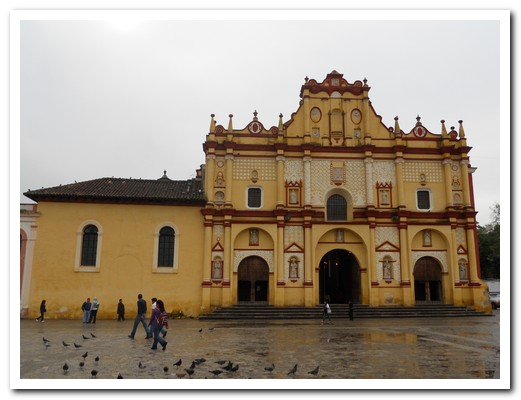
The Cathedral at San Cristóbal de Las Casas (1528 - 1815)

Women in traditional dress in the town
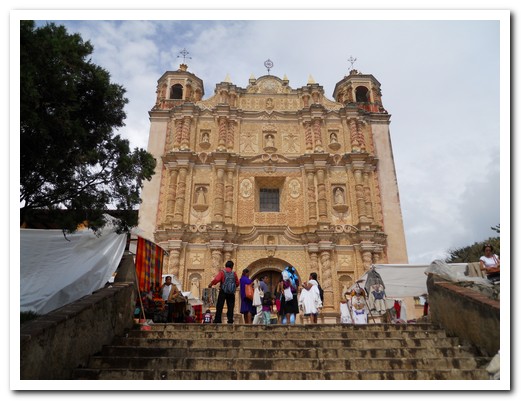
16th century Templo and ex-Convento de Santo Domingo
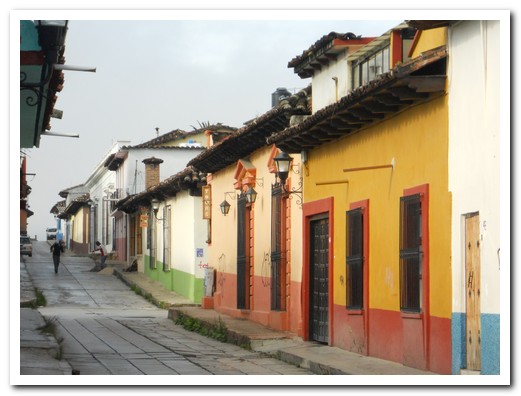
A street in San Cristóbal
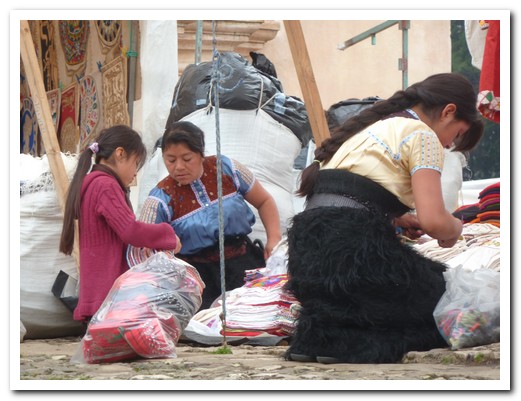
Setting up a market stall
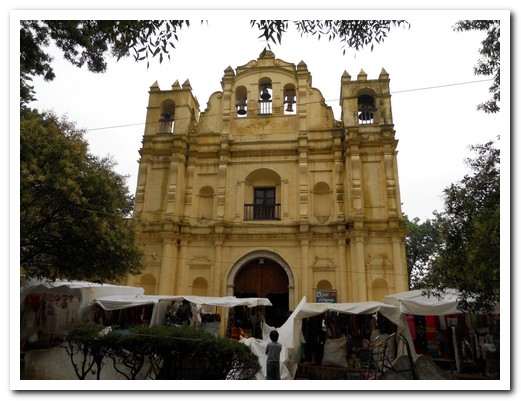
1712 Templo de la Caridad with market stalls in front
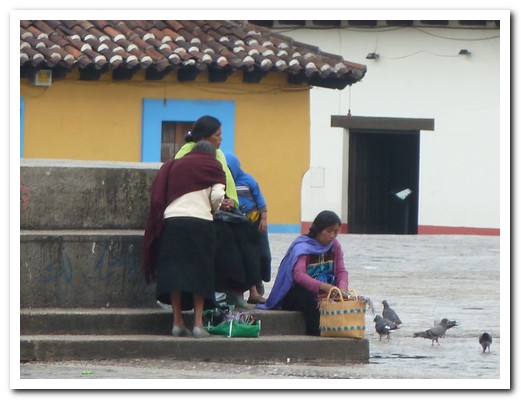
Ladies feeding pigeons in the central plaza
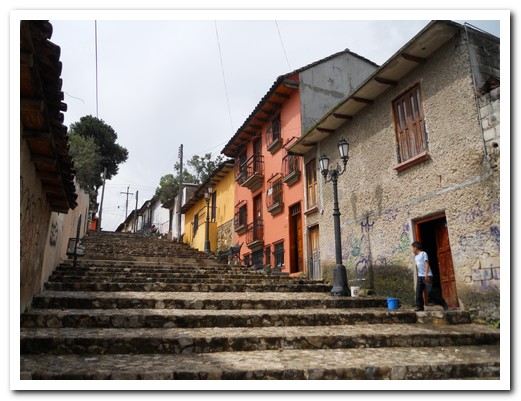
Street
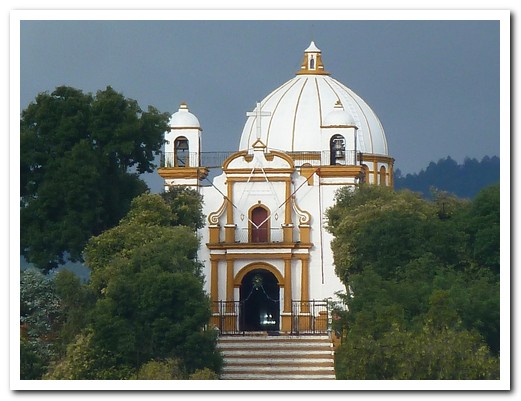
Iglesia de Guadalupe overlooks the town
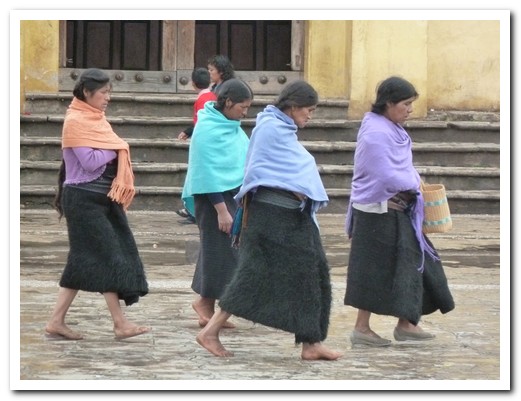
Village women in the plaza - note the furry skirts, hand loomed from sheep´s wool
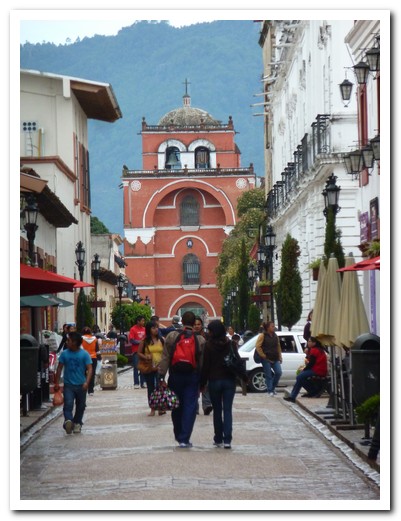
17th century city gateway Arco de El Carmen
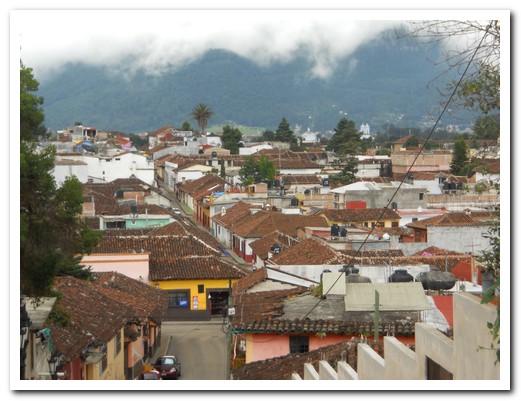
Terracotta roofs of San Cristóbal
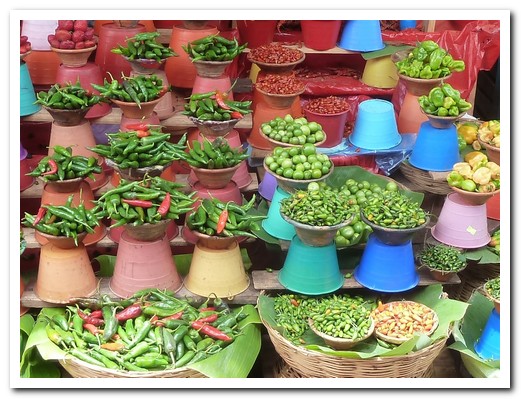
Chillies for sale at the market
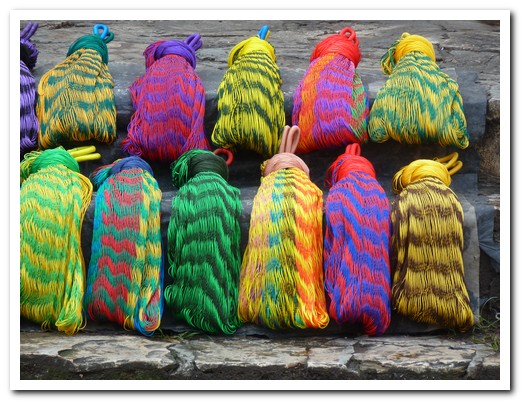
Colourful hammocks
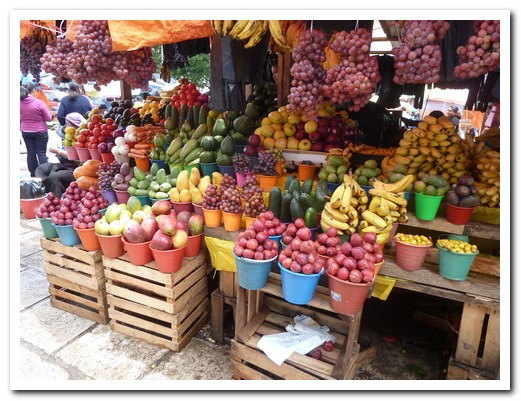
Fruit and veggies
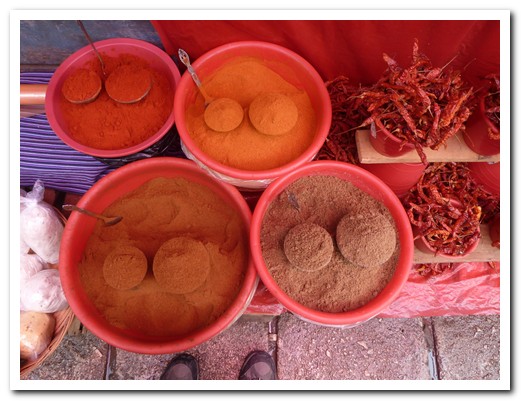
Spices
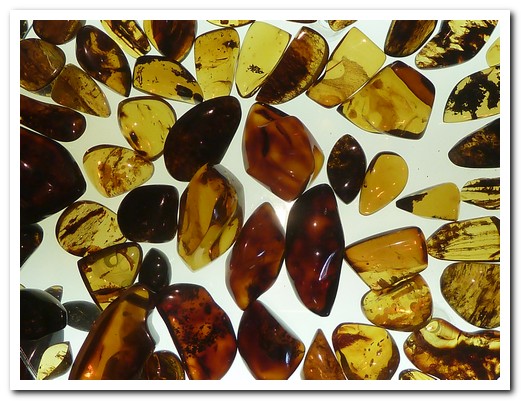
The different colours of amber sold all over town

Pam´s amber
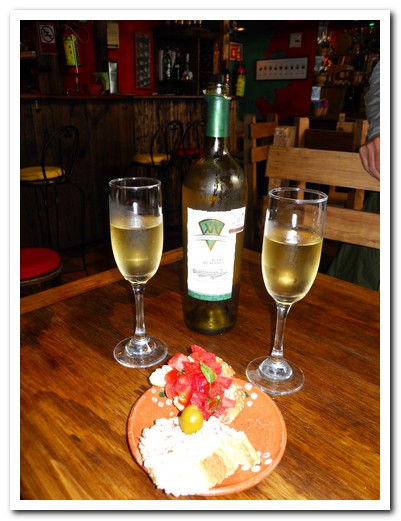
Our first Mexican wine - Domecq XA Blanc de Blancs, delicious
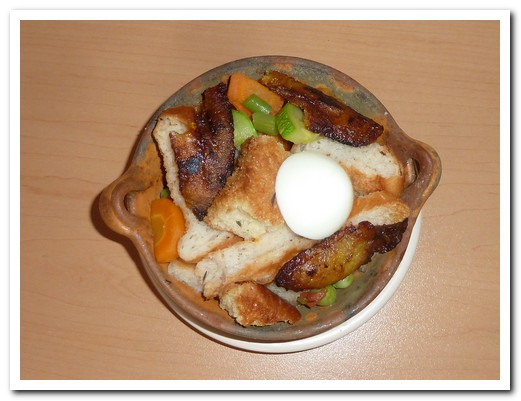
Sopa de Pan, local speciality, bread soaked in chicken stock with vegetables and banana
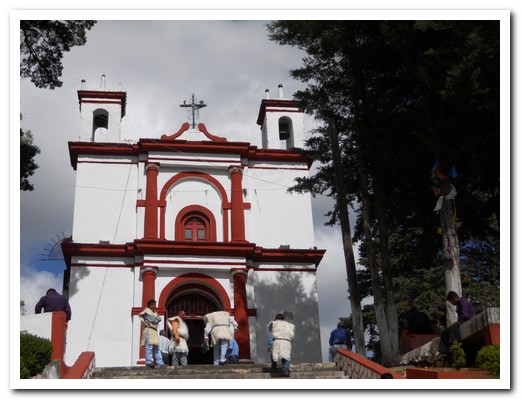
Iglesia San Cristóbal (patron Saint of travellers/drivers), high on a hill
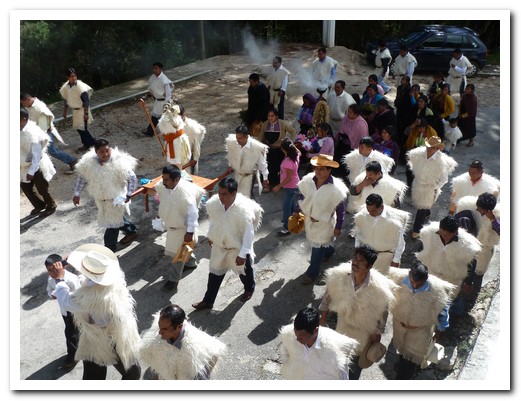
A procession of transport drivers taking the statue of San Cristóbal to Chamula
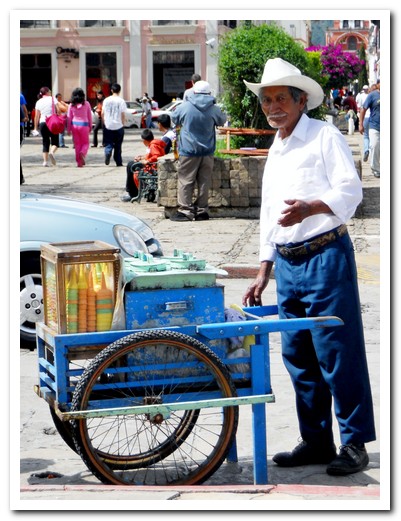
Ice-cream man in the plaza
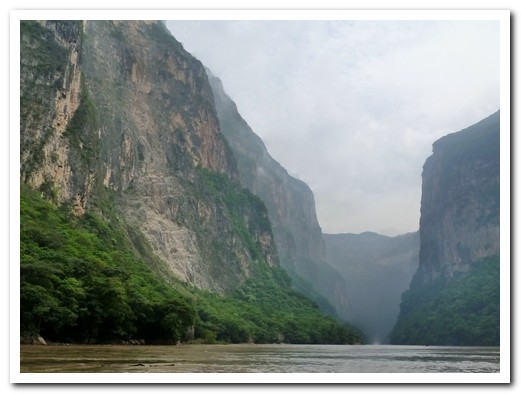
Sumidero Canyon
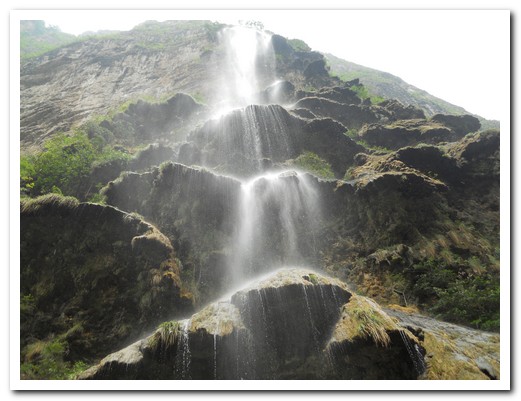
Waterfall in the Canyon
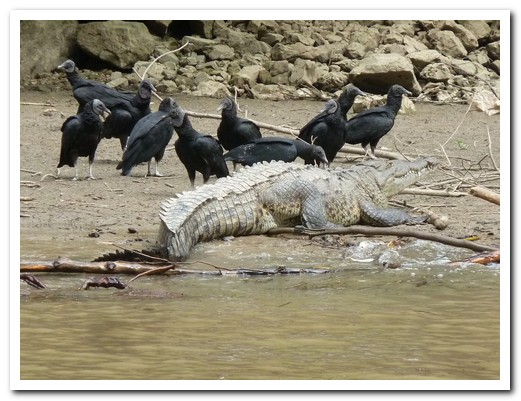
Vultures surround a crocodile
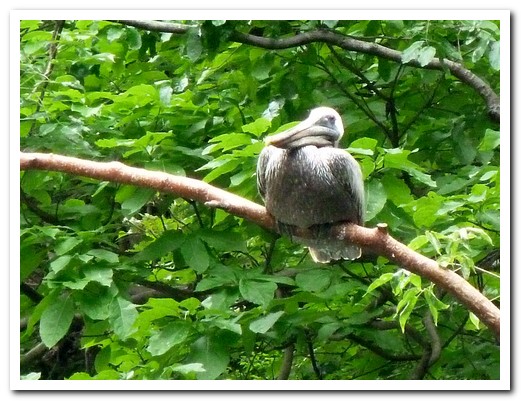
Pelican resting in a tree over the water
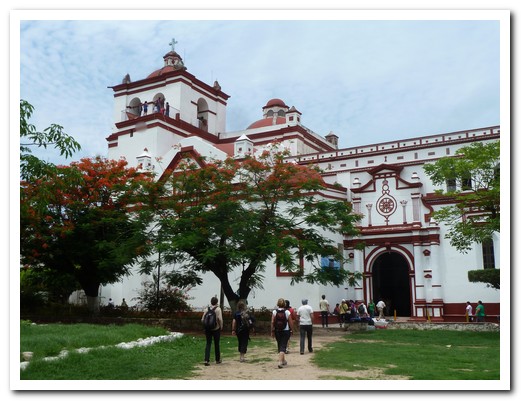
The Cathedral at Chiapa de Corzo - 16th century
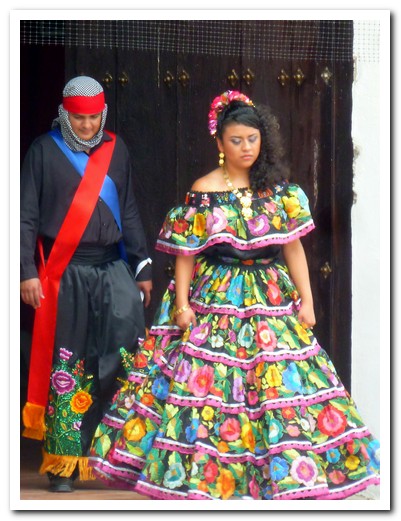
Traditional dress for fiestas
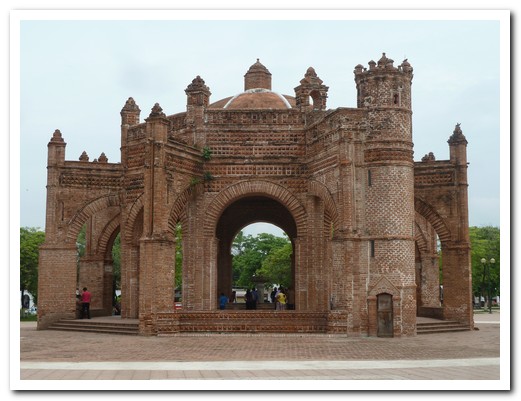
1562 fountain resembling a Spanish crown
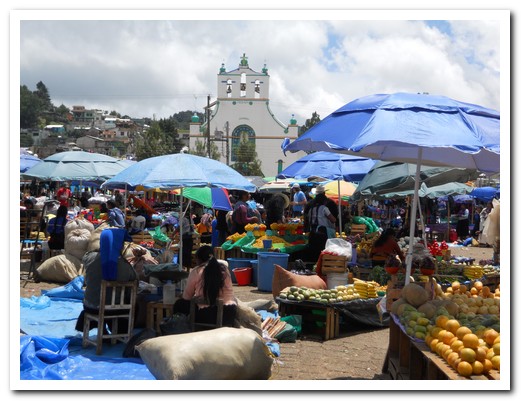
Sunday market outside the church at San Juan Chamula
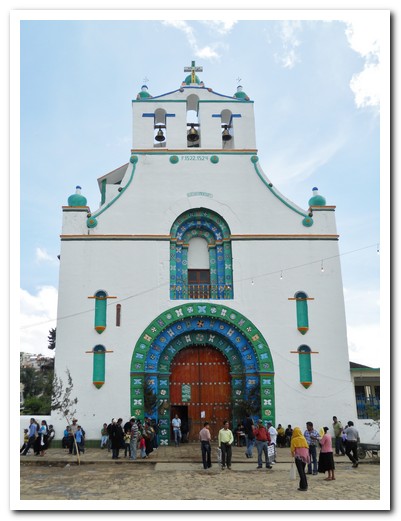
Templo de San Juan
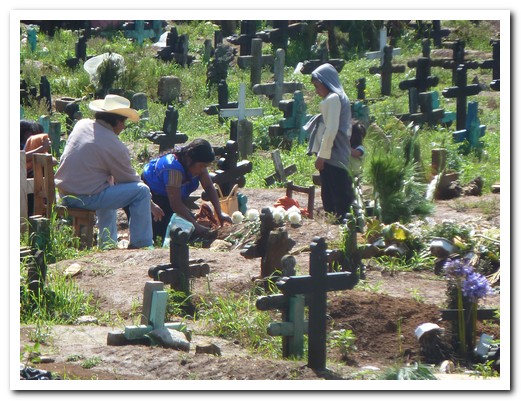
Family tending to a grave in the Mayan cemetery
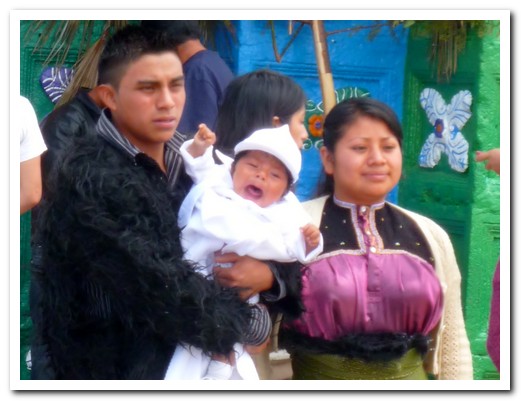
Newly baptised baby
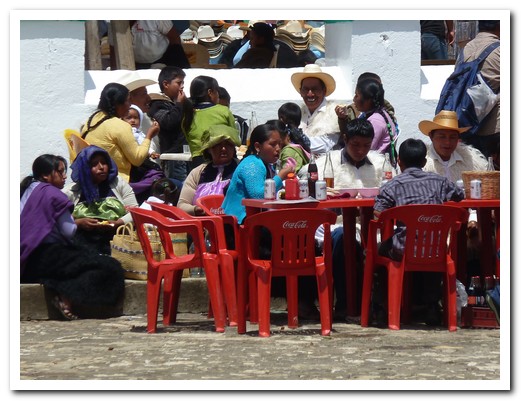
Families celebrate together after the baptism
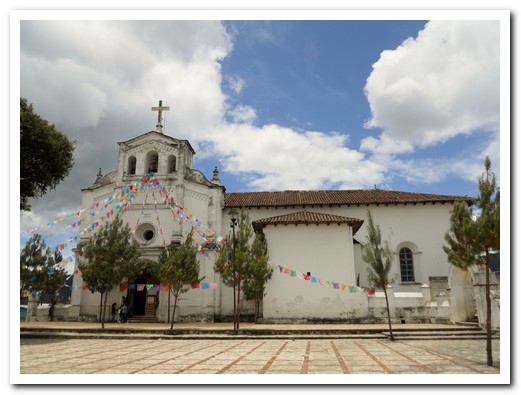
Iglesia de San Lorenzo
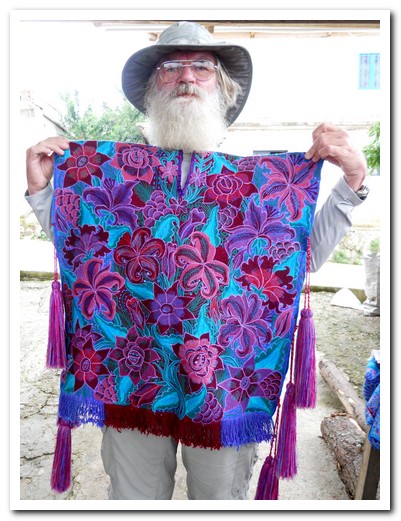
Mountain monkey tries a San Lorenzo Zinacantán men´s tunic
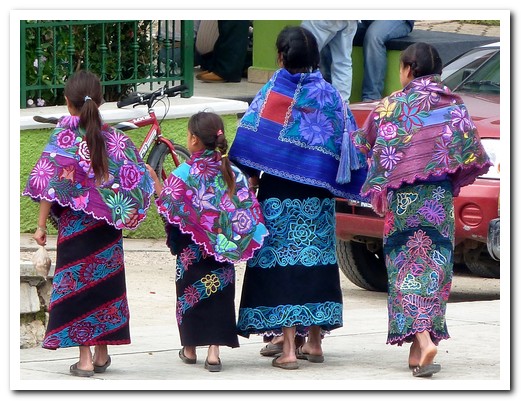
Women wear brightly embroidered skirts and shawls
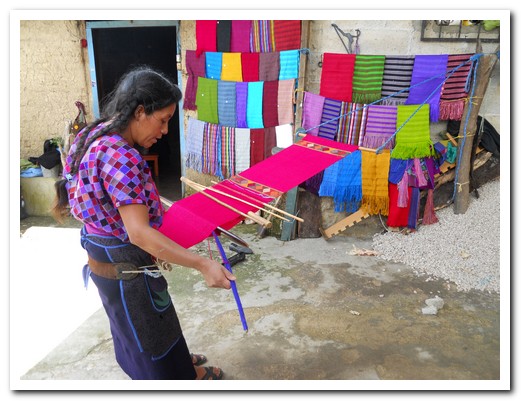
Backstrap weaving done by the village women
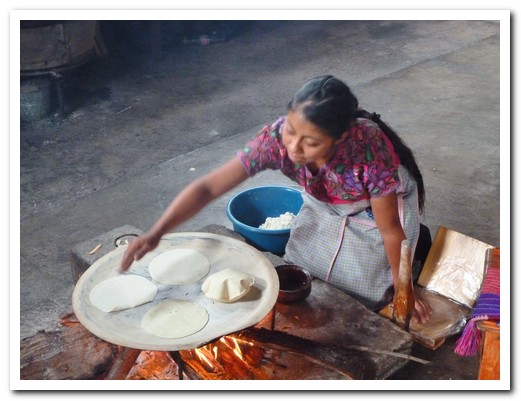
Fresh tortillas cooked on a comal over an open fire
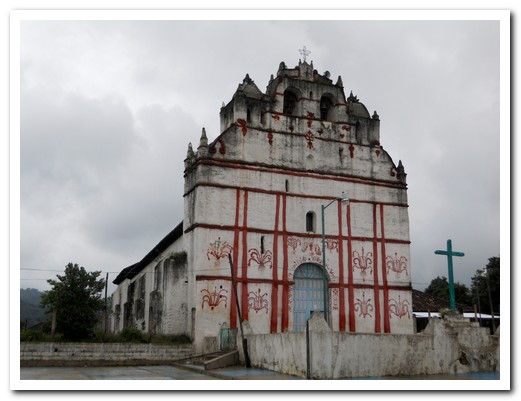
The indigenous church are Aguacatenango, walls 3 meters thick, interesting paintings

Lady hand making pottery at Amatenango
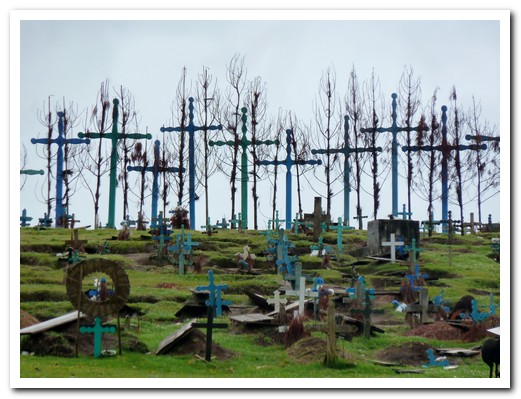
Maya cemetery at Romerillo, the boards on the graves are doors to the heavens
Campeche to Palenque
06th July 2011
Inside the old city walls of Campeche [9] are neat rows of pastel coloured historical buildings and handsome colonial churches. Over 1000 colonial buildings have been restored. The city was once the Maya settlement of Can Pech before the arrival of the Spanish in 1540. The main square comes alive in the evenings with the cathedral all lit up and bands play while people stroll.
.
The richness and variety of the food amazes us, nothing like the Mexican food we know. The specialty here is Pan de Cazón, grilled shredded baby shark on tortillas covered in a tomato sauce. We opted for Pollo Pibil instead, chicken marinated in tomato, sour oranges and spices and cooked in banana leaves. A special seed, annotte, is used to give it the rich brick colour. For lunch we tried Papadzueles, hard-boiled egg filled tortillas covered in a sauce made from summer squash seeds.
.
We followed the Gulf of Mexico south and then turned inland passing extensive wetlands to reach Villahermosa [10] where relics from the Olmec archaeological site of La Venta are displayed in an outstanding jungle setting. La Venta is 100 kilometres from Villahermosa, but the artefacts were moved here in the 1950´s for preservation. The Olmec civilization, the earliest in Mexico, thrived between 800 BC and 400 BC and left behind colossal carved stone heads displaying African characteristics.
.
Next stop was Palenque [11], located in the north western Maya lowlands, one of the most important archaeological sites in Mesoamerica. From about 100 BC it grew steadily until by 750 AD it had great splendour, some of the most outstanding Mayan buildings and a population of about 8000. The city was abandoned 150 years later (click here for the Maya Exploration Center). We stayed in the nearby town where we liked the Sopa Azteca (soup with a tomato base, smoky chillies, avocado, grilled tortillas and cheese) so much that we had it three times!
.
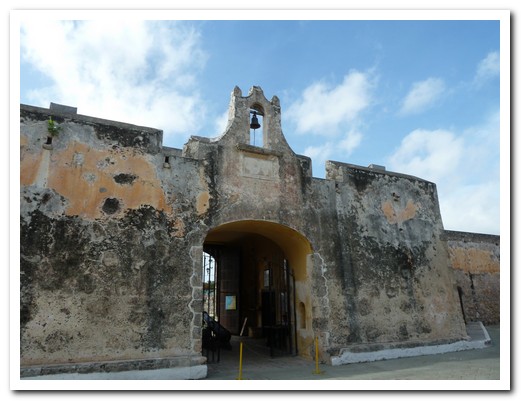
Part of the Campeche city walls
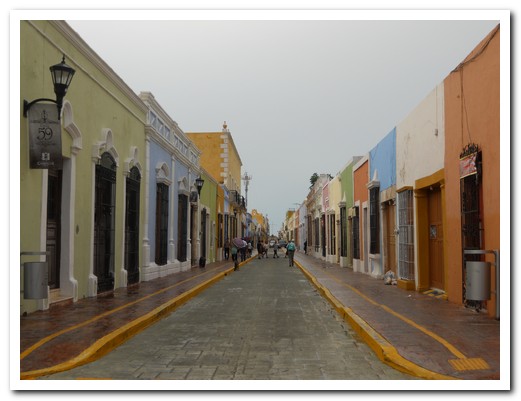
The colourful streets of Campeche
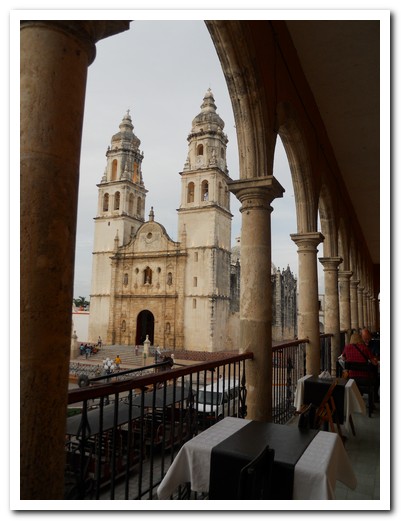
Campeche Cathedral from the Casa Vieja restaurant
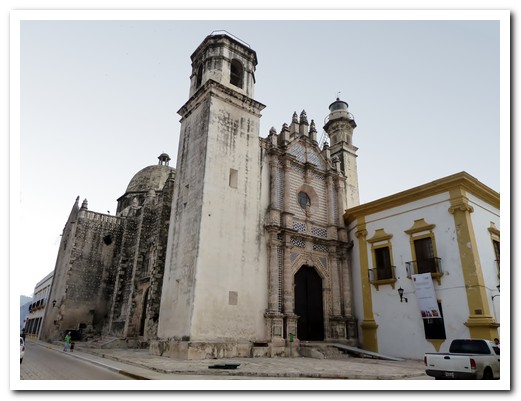
Built by the Jesuits in 1770 - Ex-Templo San José with lighthouse tower
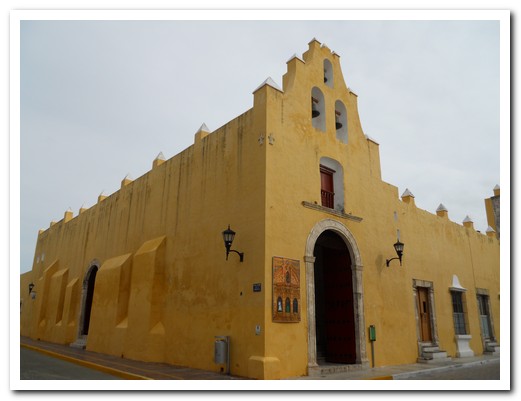
Iglesia San Francisquito
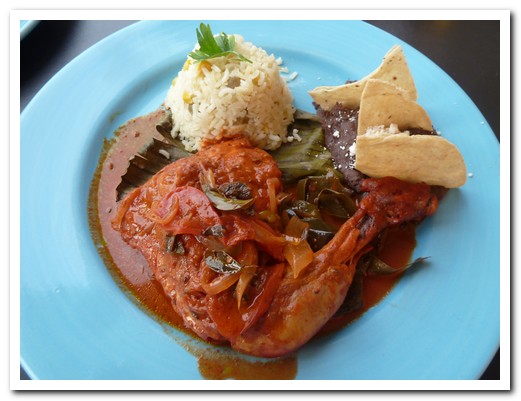
Chicken Pibil
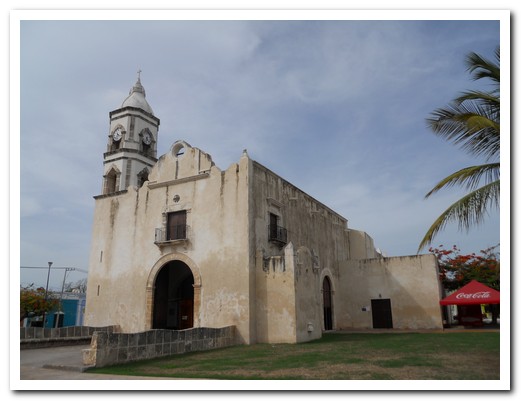
Iglesia San Rámon
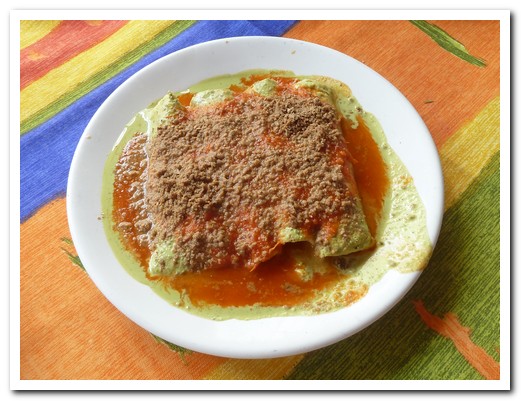
Papadzules - tortillas stuffed with egg and covered with a squash seed sauce
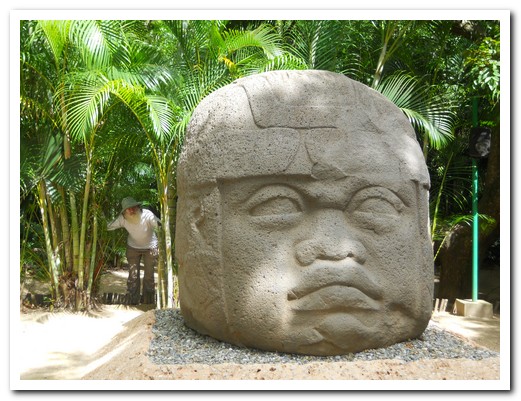
Colossal Olmec head, carved between 700 and 400 bc
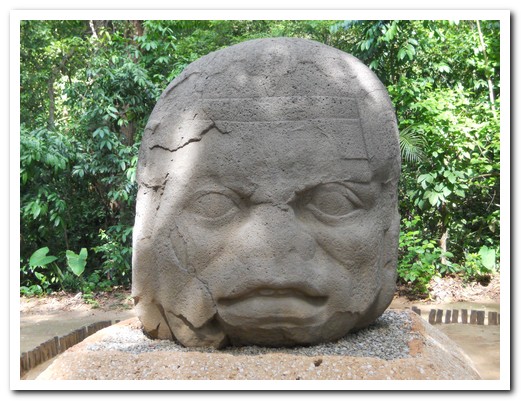
Another huge head, showing teeth
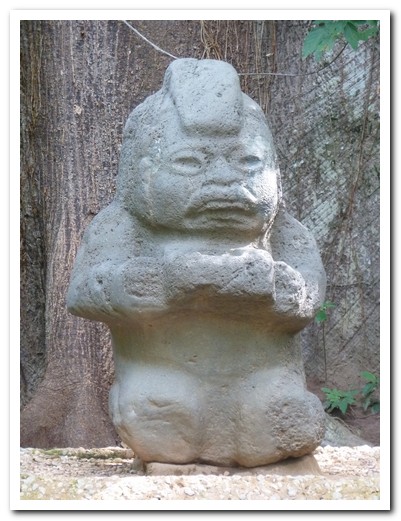
Kneeling figure of a woman holding a plate for an offering

Altar with a figure emerging from the underworld
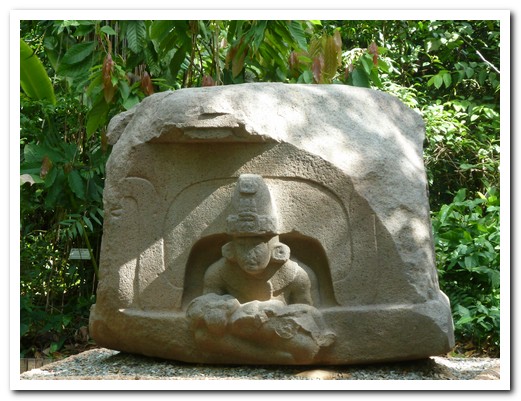
Altar with a figure carrying a child coming out of the underworld
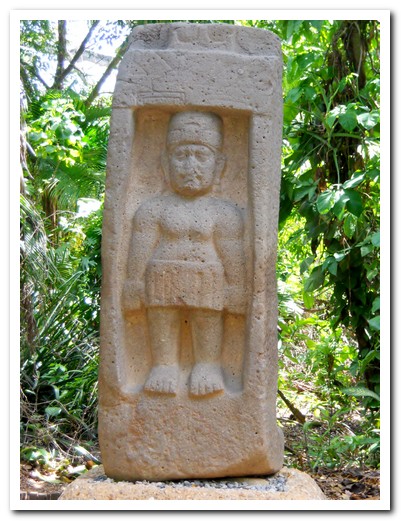
A young goddess - the Olmecs rarely carved women figures
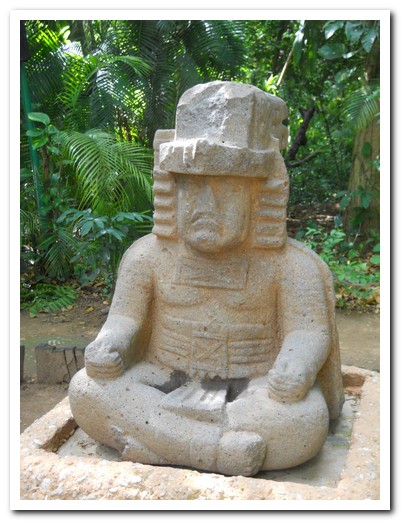
Depiction of a highly important person - called The Governor
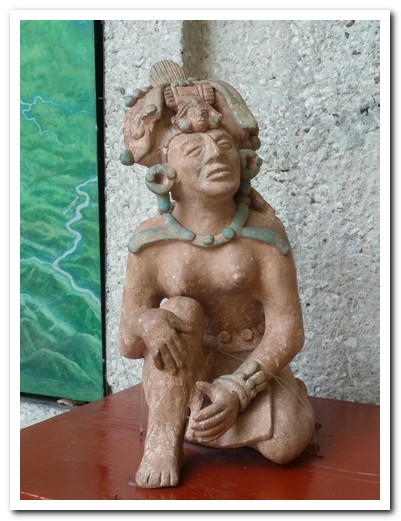
Beautiful ceramic figure in the museum
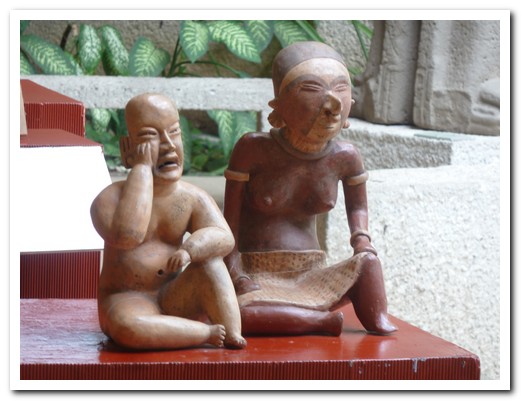
Two ceramic figures
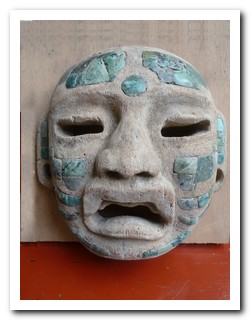 |
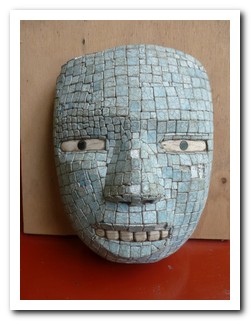 |
| Two jade funeral masks in the Olmec Museum |
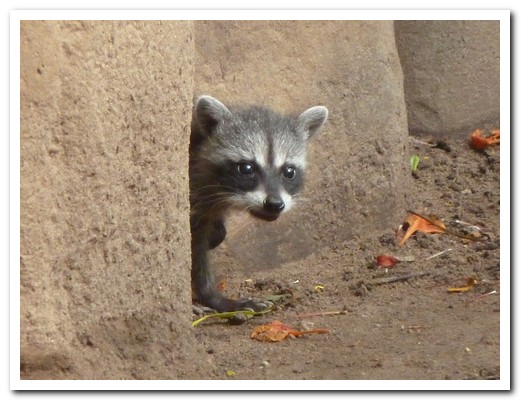
A coati hiding behind basalt columns

Badgers were everywhere in the jungle around the statues
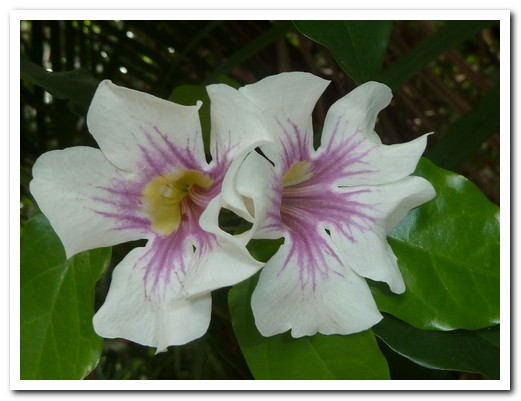
Flowers
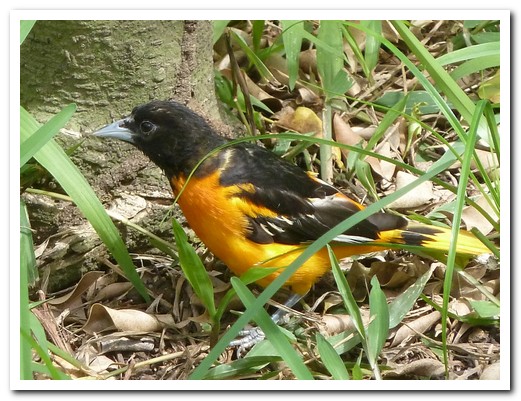
Little bird
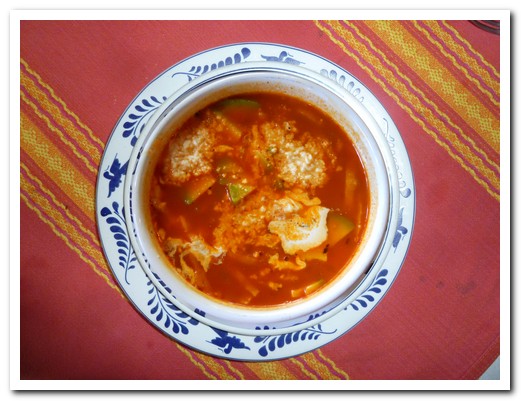
Sopa Azteca, made with tomato, chilly, avocado, tortillas and cheese
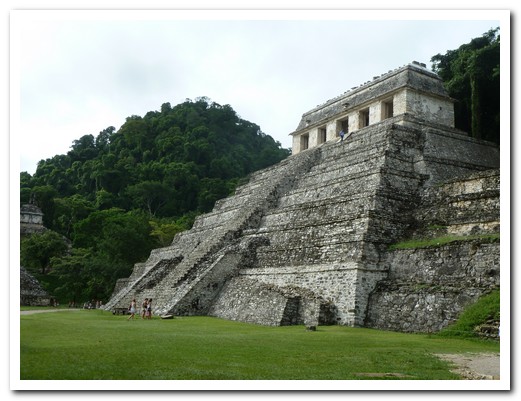
Palenque - the Temple of Inscriptions
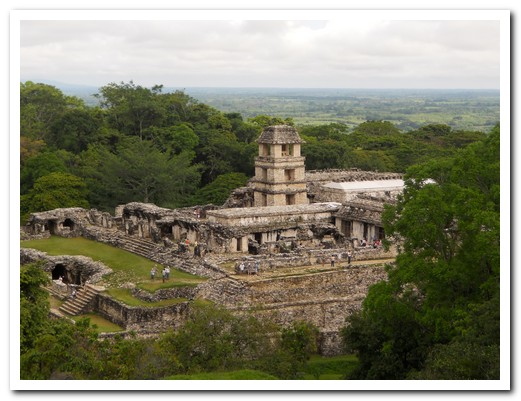
The Palace
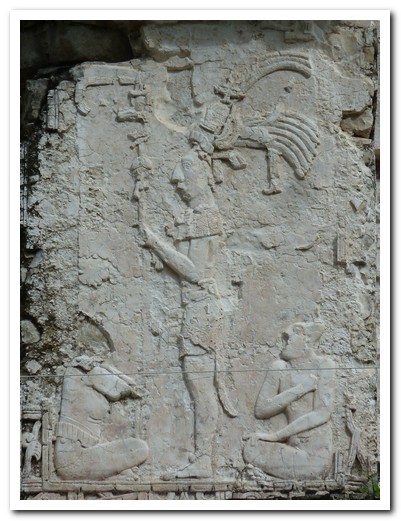
Stucco carving on the Palace
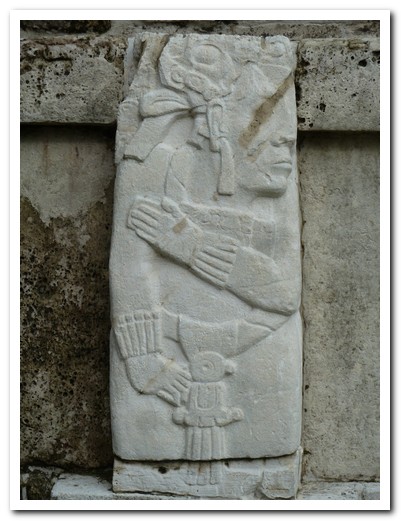
Carving on the Palace
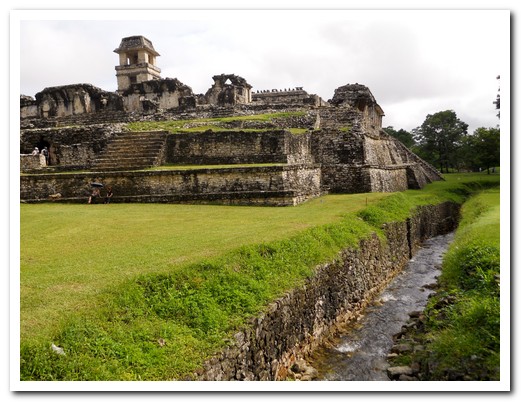
85 inches of rain a year here - the aqueduct took water under the plaza
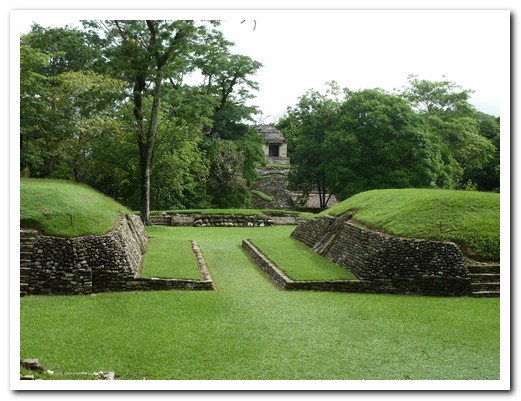
Ball court
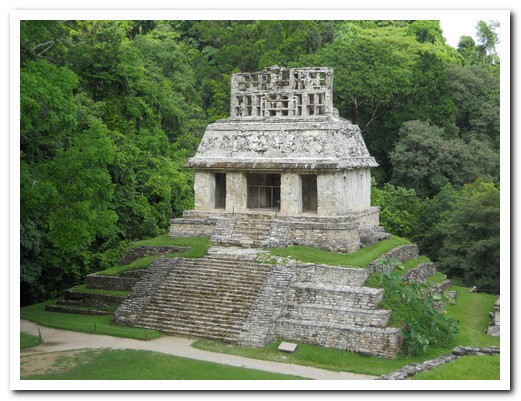
Temple of the Sun with the best preserved roof comb
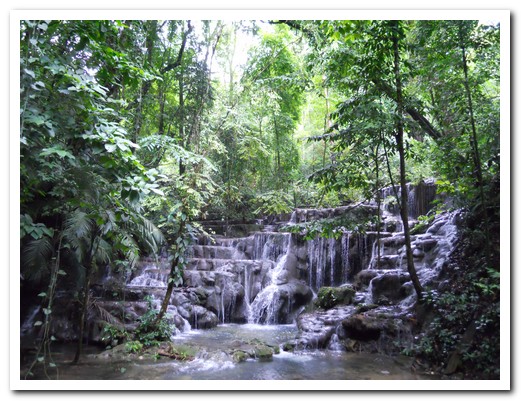
Waterfall in the grounds
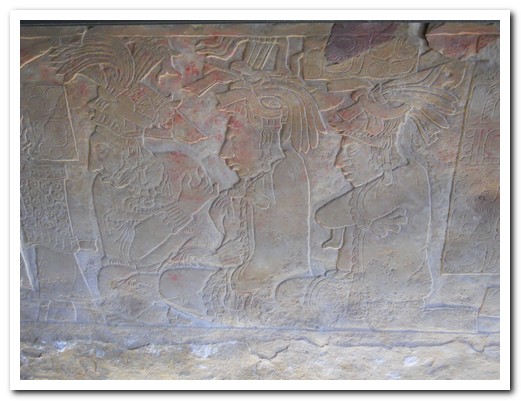
Panel in the Museum
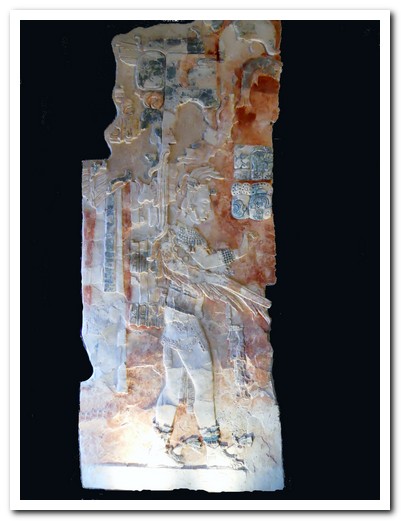
Carving with traces of colour

Clay incense burner
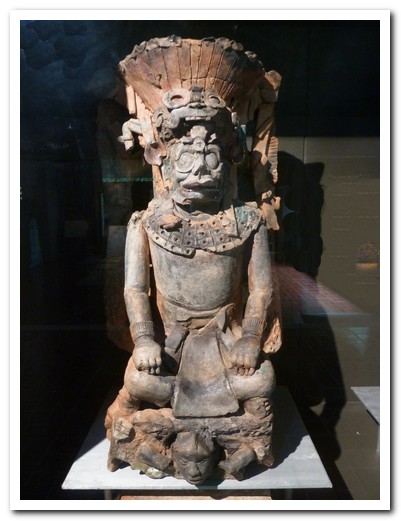
Clay figure

Jade funeral mask
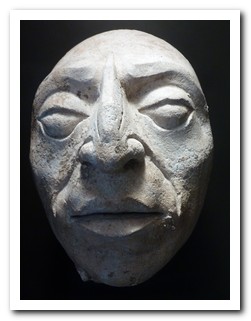 |
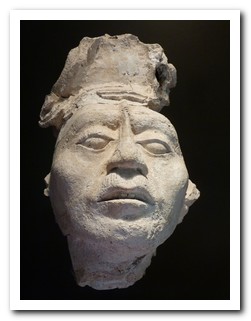 |
| Heads realistically depict important people |